Birds are one of the most fascinating creatures that mankind has ever come across. They are known for their beautiful plumage, melodious songs, and impressive flying skills.
It is no wonder that they have captured the imagination of young and old alike for centuries. Zoos have always been a great place to observe a variety of bird species up close.
These magnificent creatures have always been a significant attraction in zoos around the world, where they are often kept in large and spacious aviaries that mimic their natural habitat.
In this article, we will explore the many different types of birds that are found in zoos and discover the various reasons why they are essential to the biodiversity of our planet.
1. Cranes
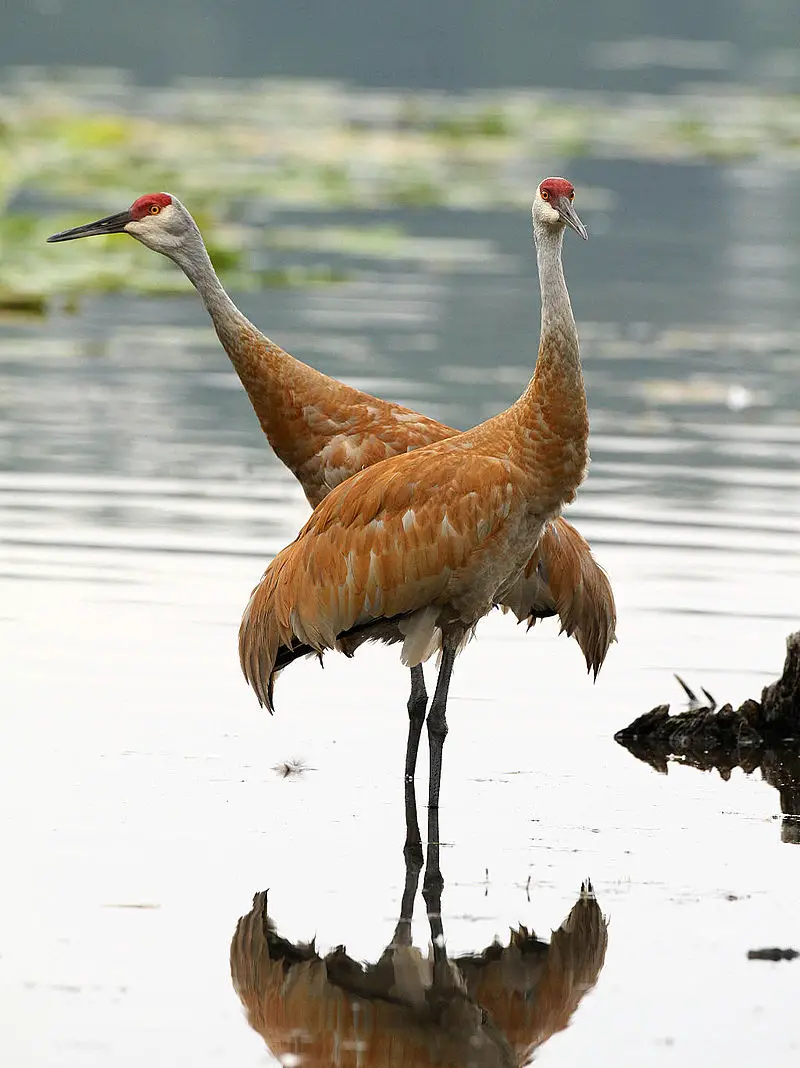
Cranes are majestic birds that can be found on most continents except Antarctica and South America. They are in the Gruiformes group of birds and belong to the family Gruidae.
Cranes have long legs, and long necks, and stand out from other birds due to their impressive size.
When they fly, they do so with their necks outstretched rather than pulled back like many other similar-looking species like herons.
There are fifteen species of cranes that are divided into three genera: Antigone, Balearica, and Grus.
They are a sight to behold and are sure to leave a lasting impression on anyone lucky enough to observe them in their natural habitat.
Scientific classification:
| Kingdom | Animalia |
| Phylum | Chordata |
| Class | Aves |
| Order | Gruiformes |
| Superfamily | Gruoidea |
| Family | GruidaeVigors, 1825 |
Also Featured In: Most Common Birds in China, Flocks Birds around Us
2. Indian Peafowl
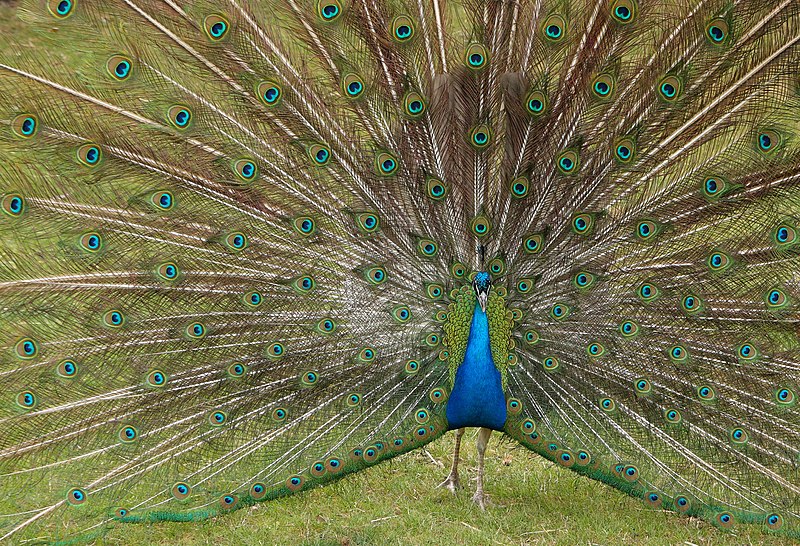
The Indian Peafowl, also known as the common peafowl or blue peafowl, is a species native to the Indian subcontinent. It has since been introduced to many other countries around the world.
Males are referred to as peacocks and females are called peahens, although both sexes can be colloquially referred to simply as “peacock”.
These birds have an impressive display of sex-specific differences in colouration; males show off their iridescent feathers in shades of green and blues while female plumage tends towards more muted browns with red accents on their tail feathers.
The mating dance performed by male Peacocks serves not only for courtship but also acts as a form of territorial advertisement between rival males over available resources such as food sources.
This colourful bird lives up its name with its beautiful displays that captivate viewers from all walks of life.
Scientific classification:
| Kingdom | Animalia |
| Phylum | Chordata |
| Class | Aves |
| Order | Galliformes |
| Family | Phasianidae |
| Genus | Pavo |
| Species | P. cristatus |
Also Featured In: Common Birds in India, Blue Birds You’ll Found around Us
3. Bald Eagle
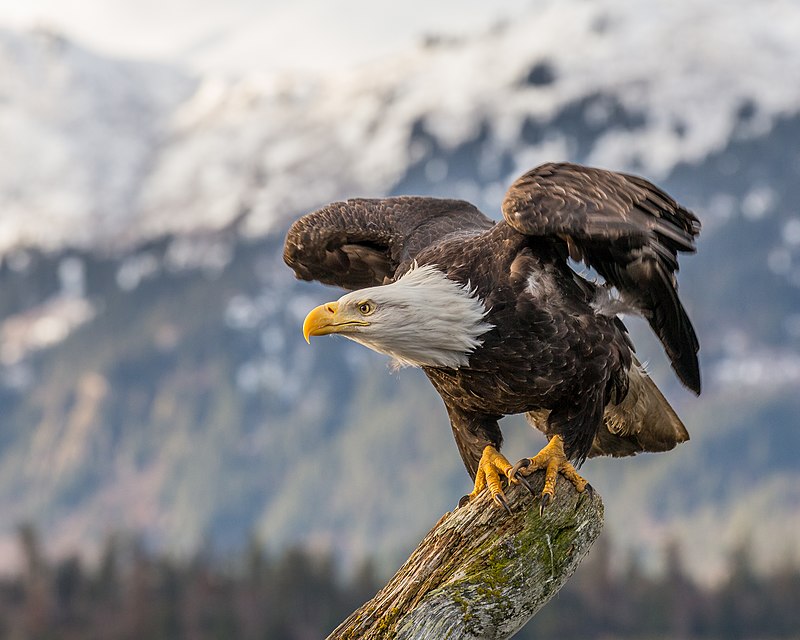
The majestic Bald Eagle is a bird of prey found in North America and recognized as the national symbol of the United States.
With its distinctive white head, brown body and striking yellow beak, this sea eagle has two known subspecies that form a species pair with the White-tailed Eagle.
It inhabits much of Canada, Alaska all states in the US contiguous area and Northern Mexico near large bodies of water where they feed mainly on fish.
These birds have an impressive wingspan ranging from 1.8 to 2 meters depending on their size making them one of nature’s most magnificent creatures.
Scientific classification:
| Kingdom | Animalia |
| Phylum | Chordata |
| Class | Aves |
| Order | Accipitriformes |
| Family | Accipitridae |
| Genus | Haliaeetus |
| Species | H. leucocephalus |
Also Featured In: Most Common United States Birds, Birds That Live in Colorado
4. Peregrine Falcon
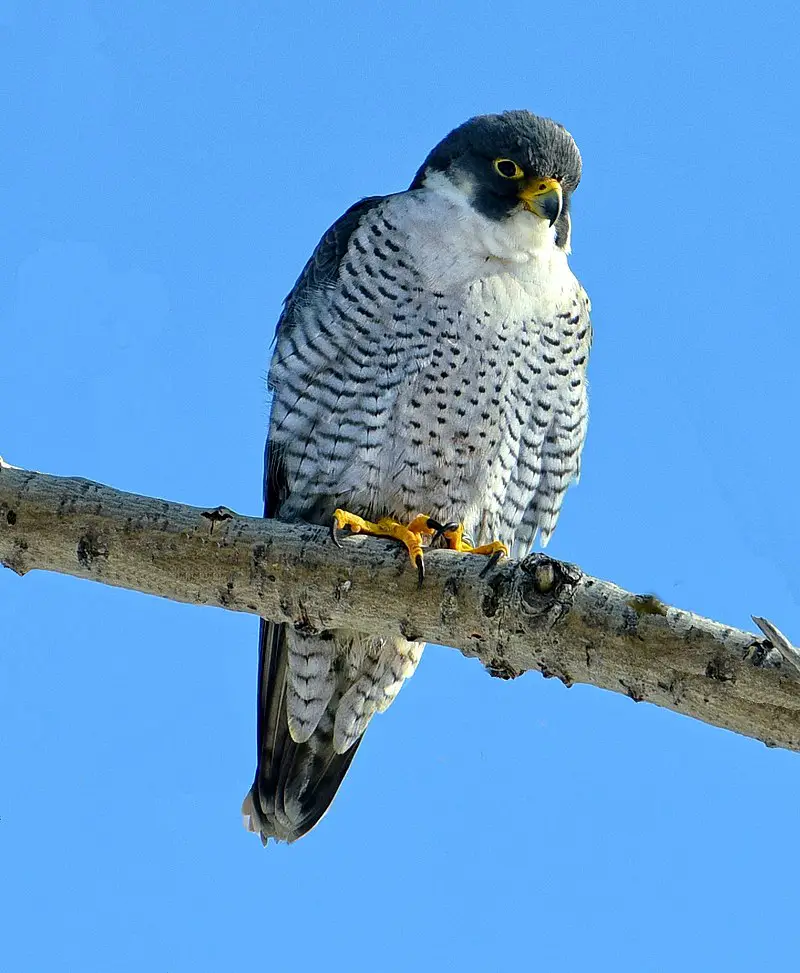
The Peregrine Falcon is a majestic bird of prey belonging to the family Falconidae. It has a blue-grey back, barred white underparts and black head making it easily recognizable.
This intelligent raptor is known for its incredible speed reaching over 320 km/h (200 mph) during hunting dives – one of the fastest animals in existence.
The peregrine falcon can be found around the world from Arctic tundra to tropical rainforests thriving with humans or in high alpine mountains far away from civilization.
With their beauty, power and adaptability they are an impressive species that have earned respect among many cultures throughout history as symbols of strength and endurance.
Scientific classification:
| Kingdom | Animalia |
| Phylum | Chordata |
| Class | Aves |
| Order | Falconiformes |
| Family | Falconidae |
| Genus | Falco |
| Species | F. peregrinus |
Also Featured In: Birds of Sweden, Common Birds in the Cities
5. Barred Owl
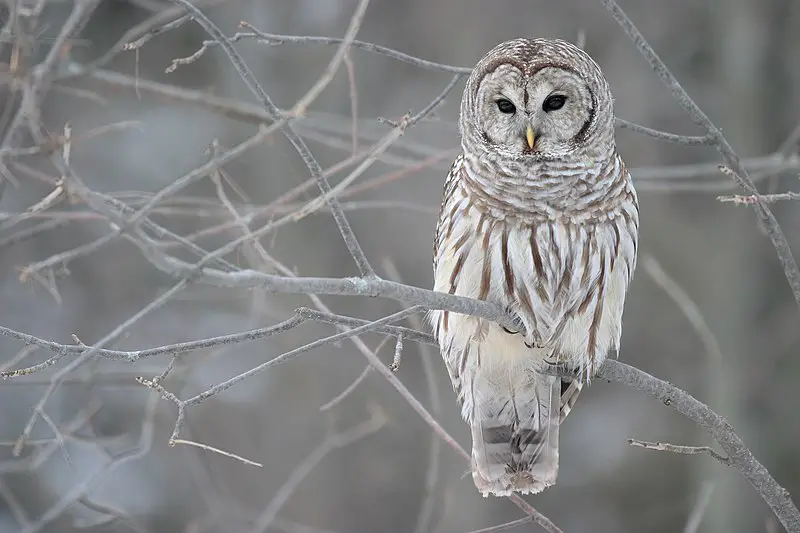
The Barred Owl is a large species of owl native to eastern North America. It belongs to the genus Strix, which is part of the true owl family Strigidae.
These beautiful birds are mainly brown with distinct stripes on their bodies and wings. Its face has dark eyes, a white chin patch and two black bars across its yellow-brownish beak, giving it an intimidating appearance.
The barred owls have powerful talons that they use for hunting small mammals like mice and voles as well as other animals such as fish, amphibians or insects.
They also rely heavily on hearing when looking for prey in low light conditions.
With their amazing camouflage abilities these birds can often remain undetected while observing potential threats from predators – making them highly successful hunters.
Scientific classification:
| Kingdom | Animalia |
| Phylum | Chordata |
| Class | Aves |
| Order | Strigiformes |
| Family | Strigidae |
| Genus | Strix |
| Species | S. varia |
Also Featured In: Most Popular Bird Species in North America, Most Common Songs Birds that Live around You
6. Great Horned Owl
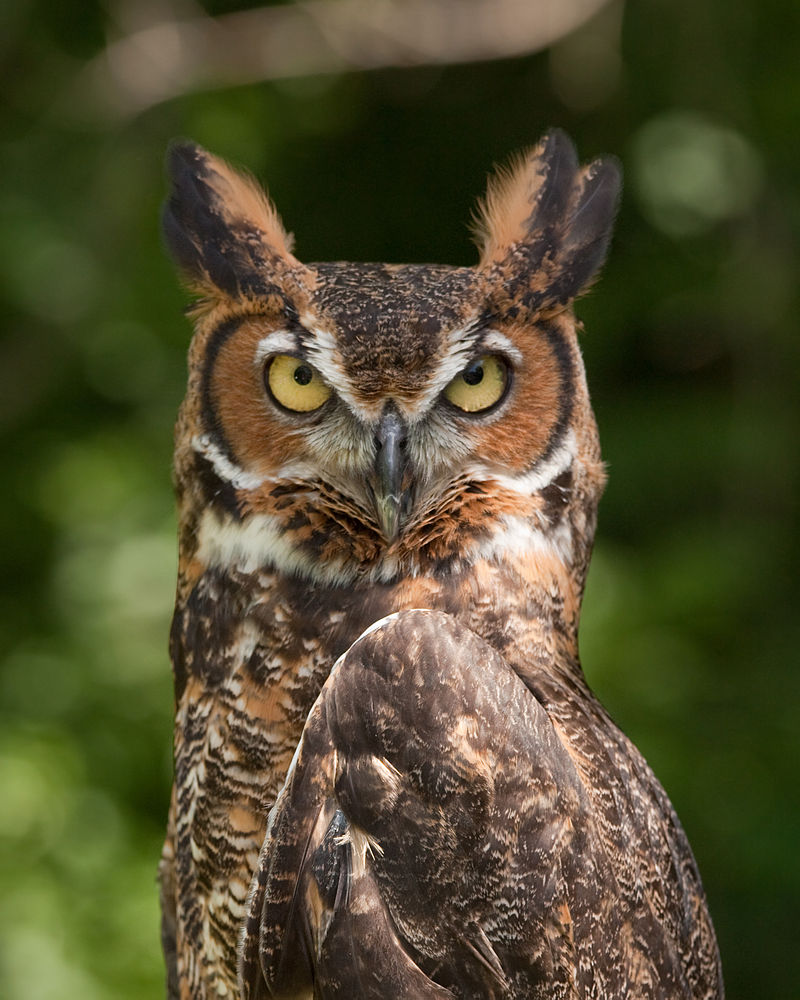
The Great Horned Owl is an impressive bird native to the Americas. It is well-known for its wide range and adaptability, as it can be found in many different habitats across the continent.
Its diet consists primarily of rabbits, hares, rats and mice; however, they are also known to consume skunks, geese and other birds too.
With their powerful talons capable of crushing prey with ease, these owls have earned themselves a fearsome reputation due to their incredible strength.
Their iconic horn-like tufts on either side of its head add another layer of intimidation which helps them stand out from other owls in the area.
Scientific classification:
| Kingdom | Animalia |
| Phylum | Chordata |
| Class | Aves |
| Order | Strigiformes |
| Family | Strigidae |
| Genus | Bubo |
| Species | B. virginianus |
Also Featured In: Birds Commonly Found in New York, Common Southern Californian Birds
7. Toco Toucan
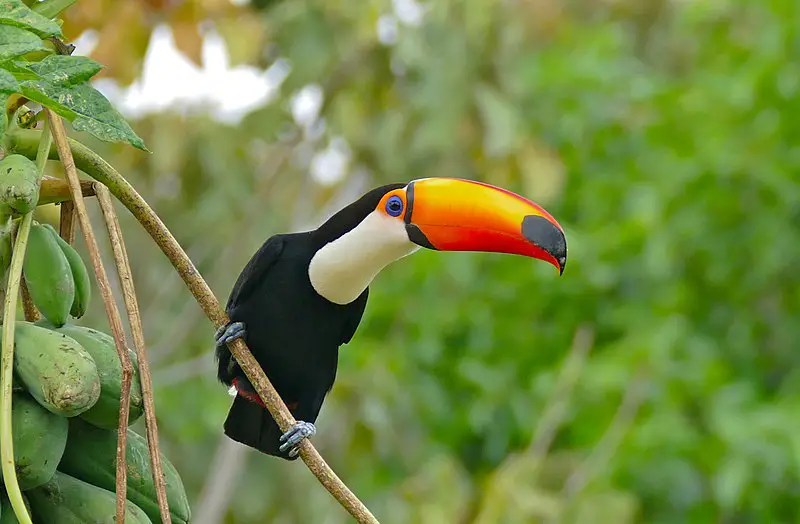
The Toco Toucan is the largest and most recognizable species of toucans, native to semi-open habitats in Central and Eastern South America.
First described by German zoologist Philipp Ludwig Statius Müller in 1776, this colorful bird has two subspecies – Ramphastos toco toco and Ramphastos toco cuvieri – distinguished by their slightly different size, plumage coloration, beak markings and range.
With its large orange bill covered with black spots along the sides of its face contrasting with yellow feathers on top of its head , it’s a very striking animal indeed.
Commonly found in zoos around the world too due tot heir loveable nature they are often kept as pets. They feed mainly on fruit but may also eat insects or small reptiles from time to time.
All in all these birds provide us a wonderful spectacle that we should appreciate for many years ahead.
Scientific classification:
| Kingdom | Animalia |
| Phylum | Chordata |
| Class | Aves |
| Order | Piciformes |
| Family | Ramphastidae |
| Genus | Ramphastos |
| Species | R. toco |
Also Featured In: Beautiful Brazilian Birds, Most Common Birds in South America Birds
8. Hyacinth Macaw
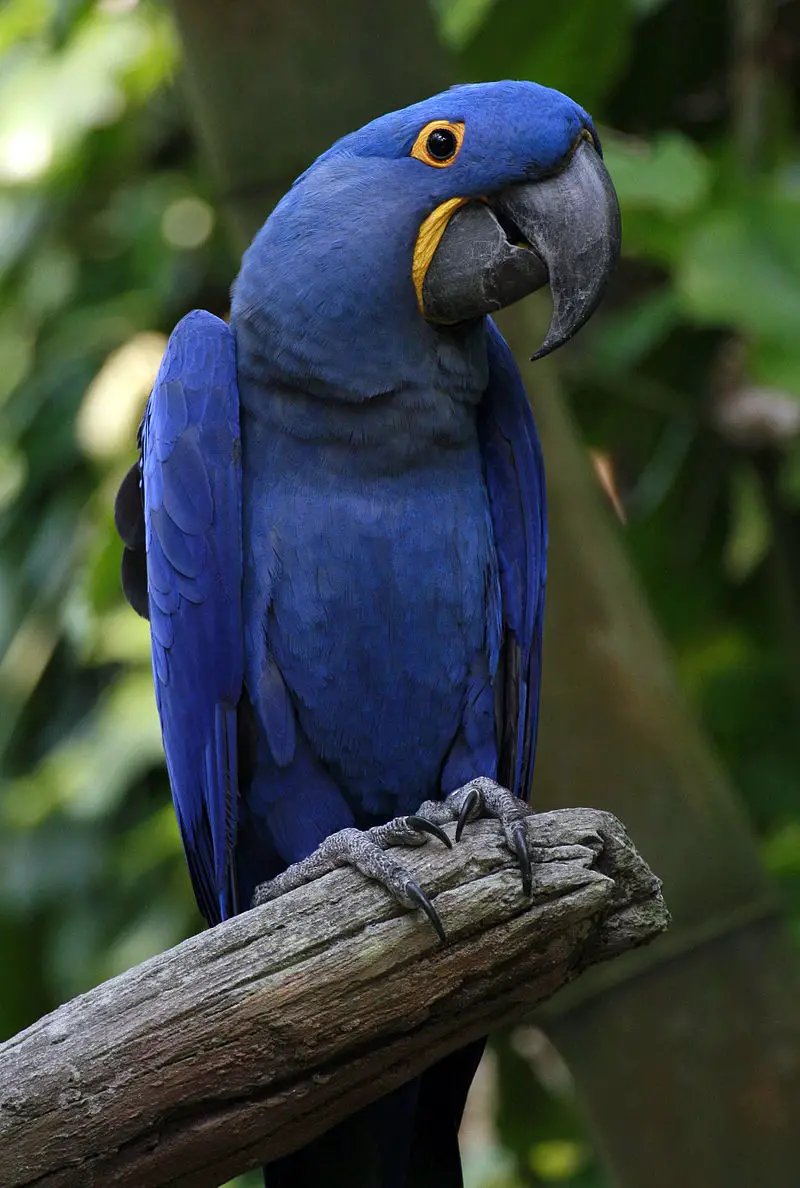
The Hyacinth Macaw is an extraordinary bird, known for its impressive size and vibrant coloration.
It has a length of around one meter, making it the longest parrot species in existence as well as the largest flying parrot species; even larger than 3.5 kg flightless Kākāpō from New Zealand.
Its striking blue plumage with yellow at its wingtips gives this majestic bird an eye-catching appearance that’s sure to turn heads wherever it goes.
Native to central and eastern South America, these birds are highly intelligent creatures who form strong bonds with their owners when kept in captivity.
They make great companions if given proper care and attention which includes providing them with plenty of space for exercise and enrichment activities such as playtime out of the cage on occasion or teaching them tricks using positive reinforcement methods like verbal praise or food rewards.
Scientific classification:
| Kingdom | Animalia |
| Phylum | Chordata |
| Class | Aves |
| Order | Psittaciformes |
| Family | Psittacidae |
| Genus | Anodorhynchus |
| Species | A. hyacinthinus |
Also Featured In: Common Latin America Birds, Common Tropical Rainforest Birds
9. Southern Screamer
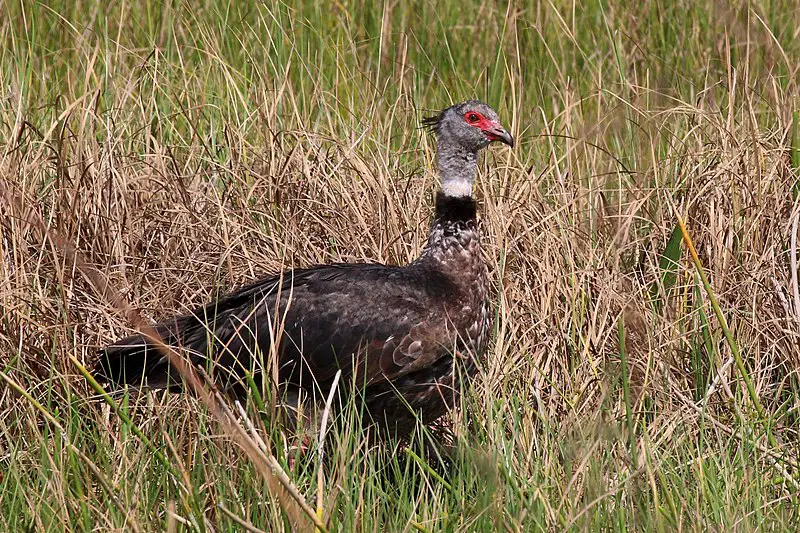
The Southern screamer is a species of bird found in South America, belonging to the family Anhimidae. It has an unmistakable call that sounds like “screaming”, earning it its name.
The plumage is primarily white and black with bright yellow eyes, legs and bill. They are large birds measuring up to 75 centimeters long from beak to tail-tip.
These birds inhabit wetlands such as swamps and marshes where they feed on seeds, grains, aquatic plants and small invertebrates which they find while wading or diving into shallow water bodies.
Despite their loud calls when alarmed or disturbed these birds have adapted well to human presence by living around agricultural areas near humans settlements where food sources are plentiful making them quite common within their range.
Scientific classification:
| Kingdom | Animalia |
| Phylum | Chordata |
| Class | Aves |
| Order | Anseriformes |
| Family | Anhimidae |
| Genus | Chauna |
| Species | C. torquata |
10. Scarlet Ibis
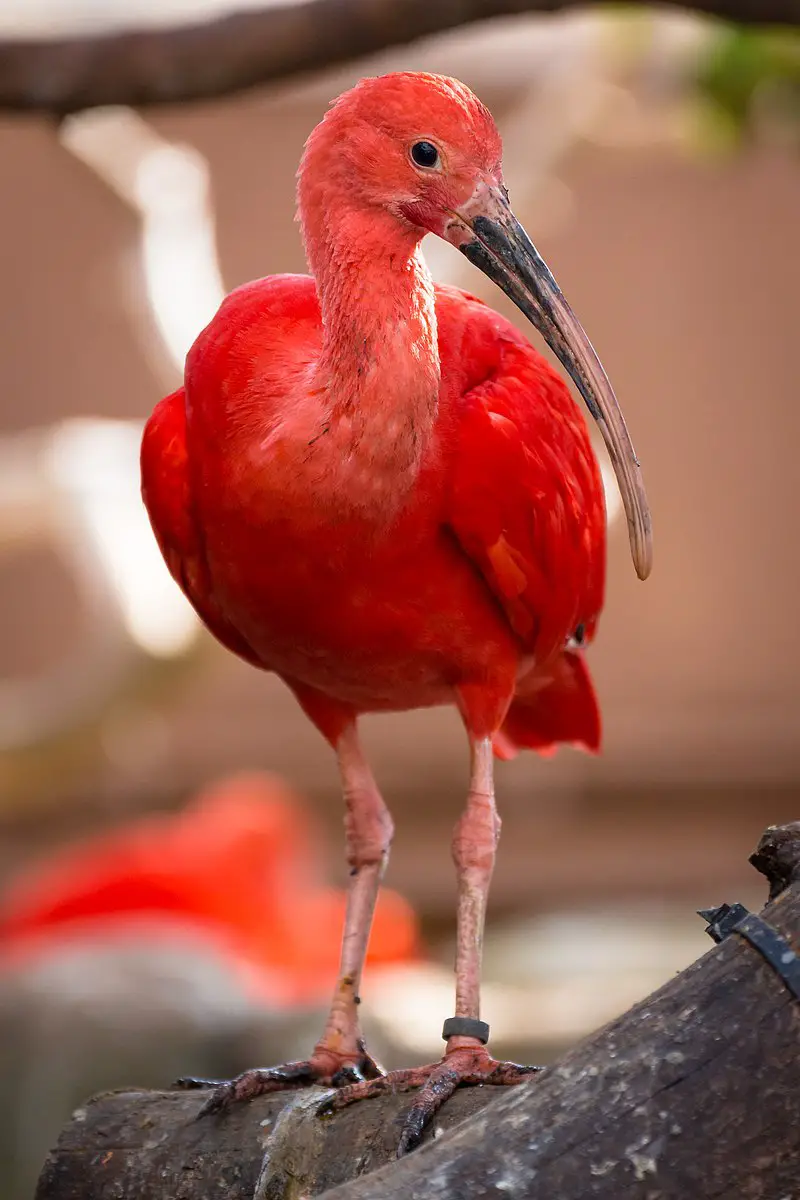
The Scarlet Ibis is a stunning bird, native to tropical South America and the Caribbean. With its distinctive scarlet coloration, it stands out from other ibises in the Threskiornithidae family.
It has become one of two national birds of Trinidad and Tobago with a Tupi-Guarani name: guará.
This species can grow up to 28 inches long with an impressive wingspan of 39–41 inches wide.
The striking red feathers are found mainly on their body while wings, head and neck range from white or greyish colors.
They have black legs with pink webbed feet that help them thrive as they wade through shallow water searching for food such as shrimp, crabs and small fish – all essential components to their diet.
Despite its beauty, this species faces threats due increasing habitat destruction caused by deforestation practices in areas where it lives making conservation efforts crucial for protecting these majestic creatures before they disappear forever.
Scientific classification:
| Kingdom | Animalia |
| Phylum | Chordata |
| Class | Aves |
| Order | Pelecaniformes |
| Family | Threskiornithidae |
| Genus | Eudocimus |
| Species | E. ruber |
Also Featured In: Spiritual Birds,
11. Blue-And-Yellow Macaw
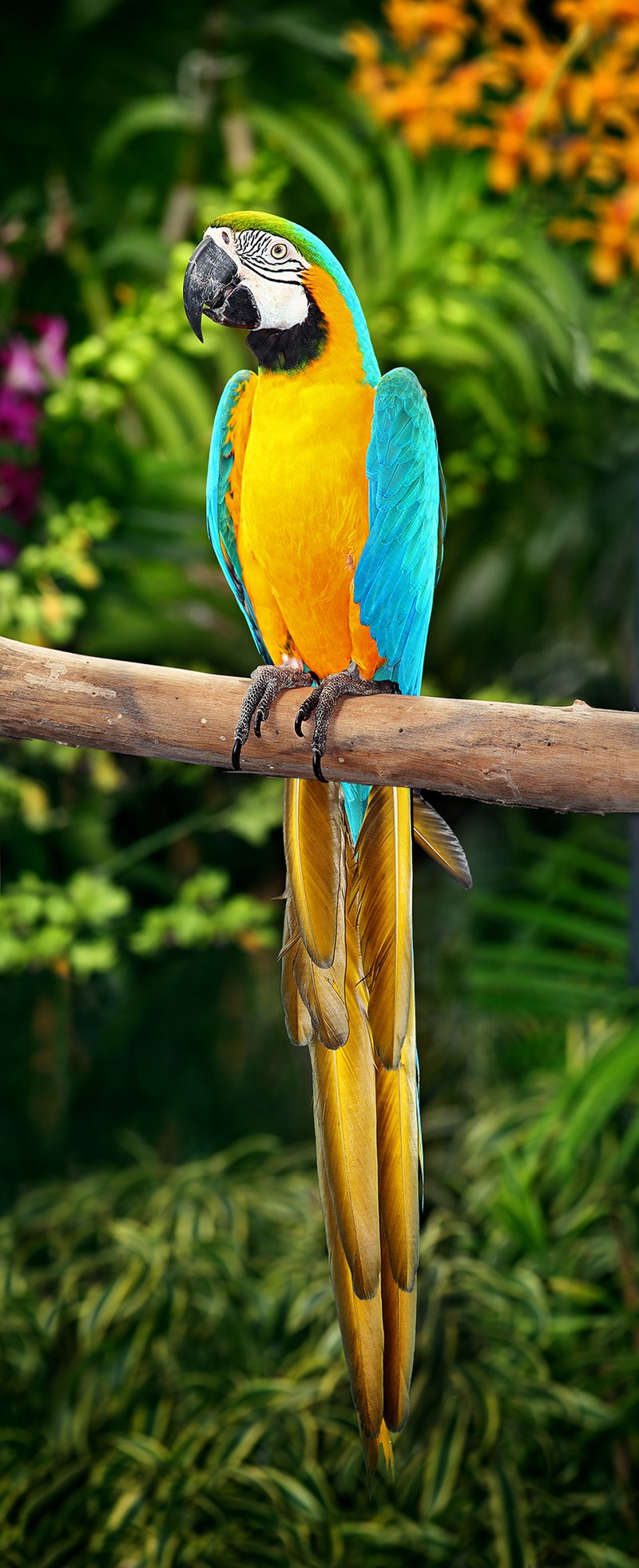
The Blue-and-yellow Macaw is a vibrant and eye catching bird native to South America. It has beautiful blue top parts, light orange underparts, and green on its head.
This large parrot lives in the tropical forests of varzea, terra firme or unflooded forest areas.
They are social birds that live in small flocks which can range from two to twenty birds during breeding season when they look for mates.
They feed mainly on seeds, nuts and fruits but sometimes also eat insects like beetles and caterpillars as well as tender shoots from trees & plants.
These macaws have an impressive call with loud screams used both to attract mates and communicate between members of their flock while flying long distances across open fields together.
Scientific classification:
| Kingdom | Animalia |
| Phylum | Chordata |
| Class | Aves |
| Order | Psittaciformes |
| Family | Psittacidae |
| Genus | Ara |
| Species | A. ararauna |
Also Featured In: Case Birds that Live in with Us, Pet Birds that Live in India
12. Turkey Vulture
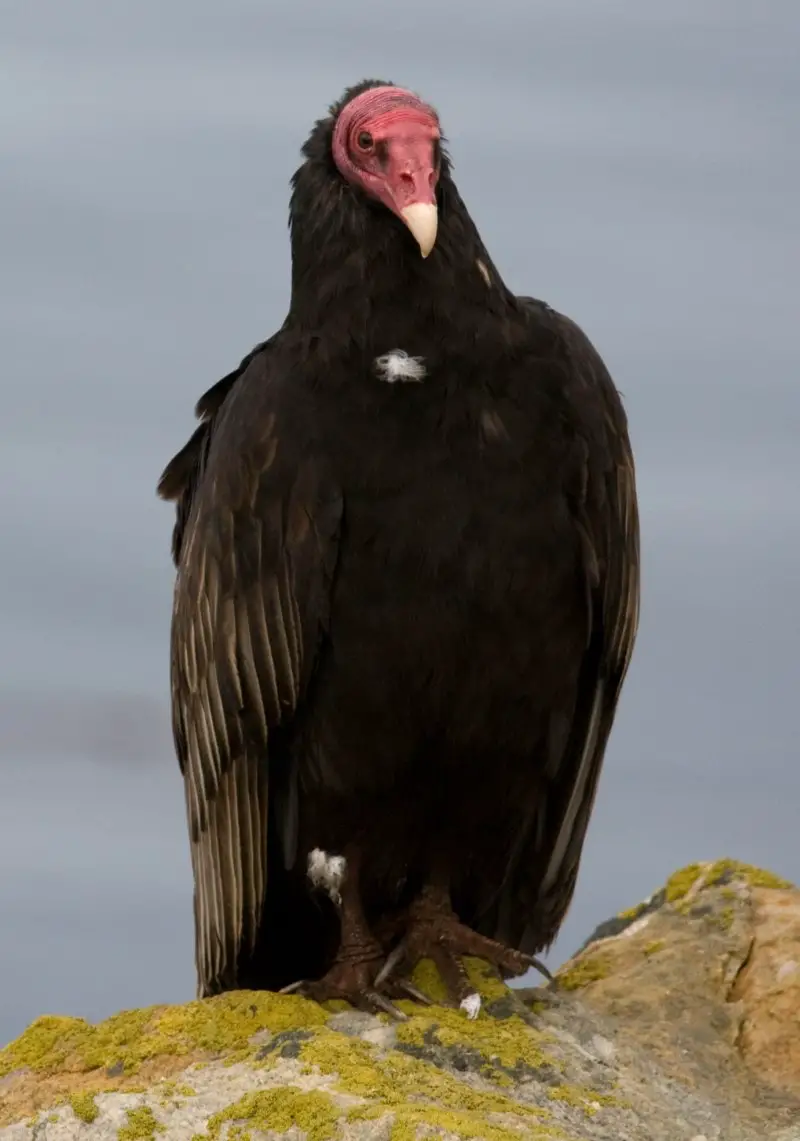
The turkey vulture is a large bird of prey that can be found in many parts of the world. It has a wingspan of up to 6 feet and its feathers are mostly black with brownish-red patches on the underside which give it an overall dark red appearance.
Its head is bald, which helps protect it from getting overheated when flying long distances looking for food.
The Turkey Vulture usually feeds off carrion but will also feed on fruit and insects.
Its keen eyesight allows them to spot potential meals from miles away while they soar through the sky using their broad wings and thermal air currents to stay aloft without expending much energy.
They are very important scavengers as they keep ecosystems healthy by consuming dead animals before disease can spread amongst living creatures or contaminate local water sources like rivers or lakes.
Scientific classification:
| Kingdom | Animalia |
| Phylum | Chordata |
| Class | Aves |
| Order | Accipitriformes |
| Family | Cathartidae |
| Genus | Cathartes |
| Species | C. aura |
Also Featured In: Top Birds Found in Mexico, Turkey Birds You Should Know
13. Spur-Winged Lapwing
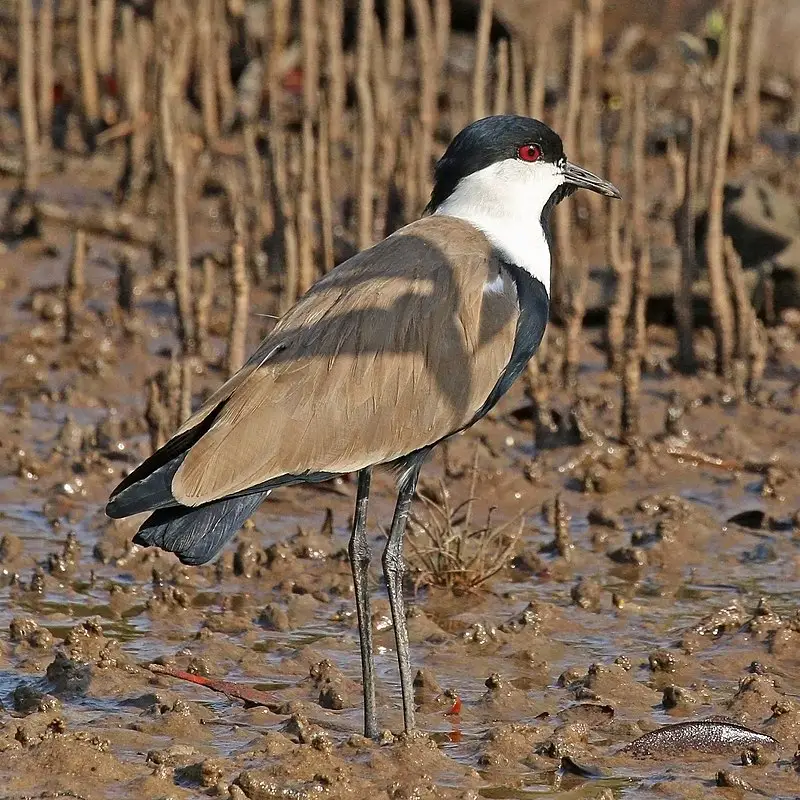
The Spur-winged Lapwing is a species of wader found in the family Charadriidae.
It breeds around the eastern Mediterranean and Africa, where it inhabits savannahs, wetlands and grasslands.
Its plumage is mainly black with white wing stripes and yellow legs.
This bird has an impressive crest on its head that gives it a distinctive look amongst other lapwings.
The most interesting feature of this bird though is the spurs on its wings which are believed to be part of an unattested cleaning symbiosis between them and Nile crocodiles.
It feeds mostly on insects, larvae, worms as well as some plant material such as seeds or fruits.
Overall these birds can live up to 15 years in their natural habitat making them one of longest lived among all wading species.
Scientific classification:
| Kingdom | Animalia |
| Phylum | Chordata |
| Class | Aves |
| Order | Charadriiformes |
| Family | Charadriidae |
| Genus | Vanellus |
| Species | V. spinosus |
Also Featured In: Common Ethiopian Birds, Common Birds of Lesbos Island
14. Tawny Owl
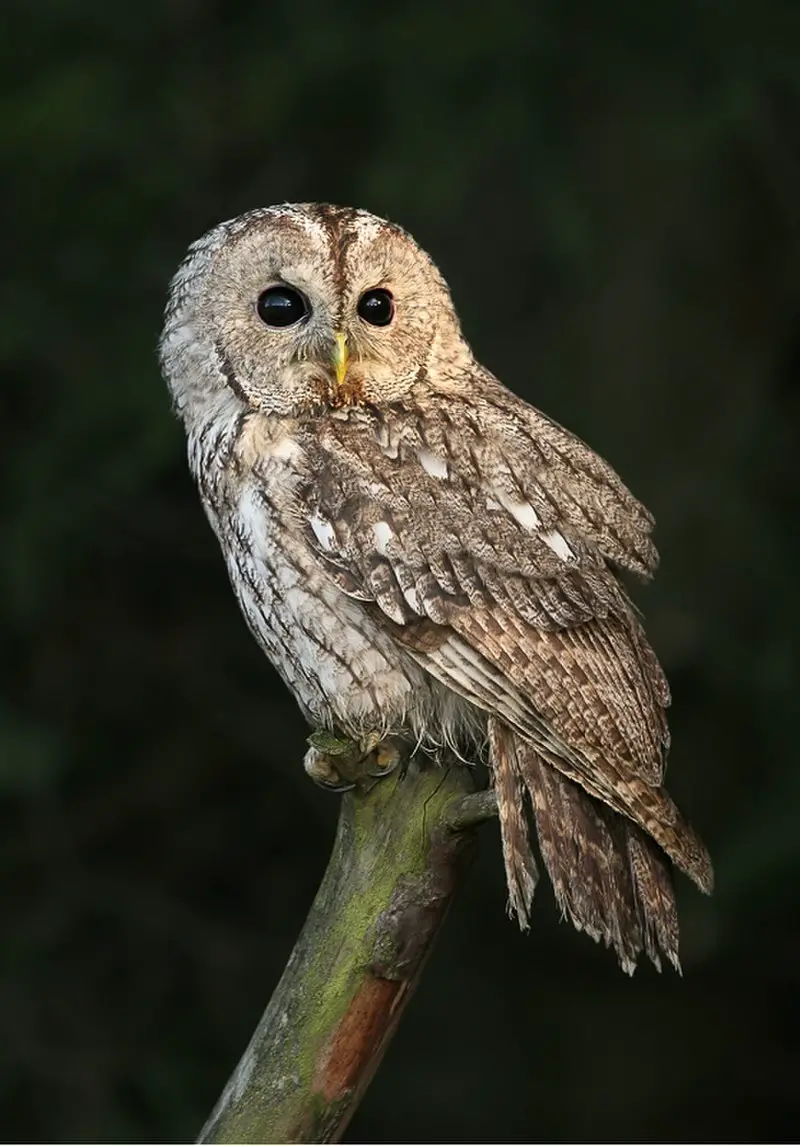
The Tawny Owl is a stunning bird found in woodlands throughout Europe to western Siberia. It has seven recognized subspecies, each with its own subtle differences.
This stocky owl usually has pale underparts with dark streaks and either brown or gray upper feathers. They build their nests high up in tree holes and are very territorial when it comes to protecting them.
During the day they roost quietly among branches of trees but become quite active at night as they hunt small mammals like mice and shrews using their extraordinary hearing skills.
The tawny owl’s call can be heard echoing through forests on still nights making it one of the most recognizable owls around.
Scientific classification:
| Kingdom | Animalia |
| Phylum | Chordata |
| Class | Aves |
| Order | Strigiformes |
| Family | Strigidae |
| Genus | Strix |
| Species | S. aluco |
Also Featured In: Native Birds Of Germany, Most Common Lithuanian Birds
15. Eurasian Eagle-Owl
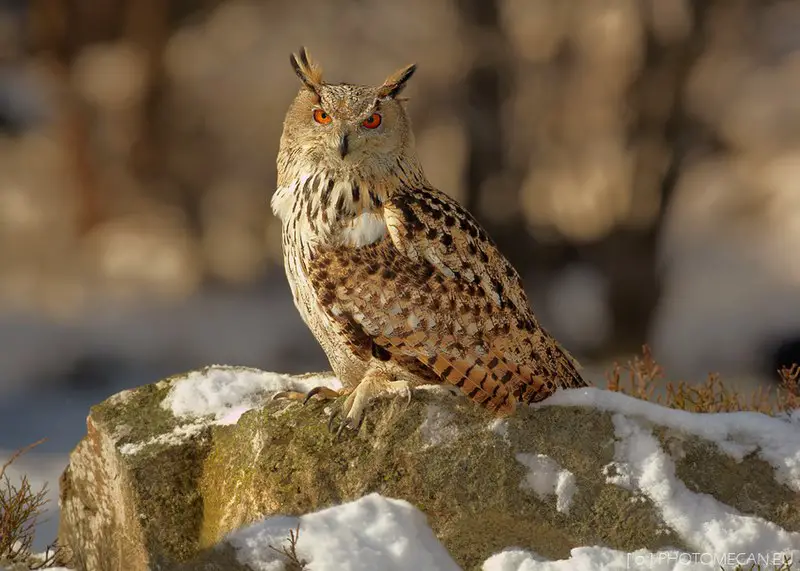
The Eurasian eagle-owl is a majestic bird that inhabits much of Eurasia. It has an impressive wingspan of up to 6 ft 2 in, and females can reach lengths of 30 inches.
The Uhu, as it is sometimes called, boasts distinctive ear tufts which are easily visible against its mottled brown plumage.
This powerful owl preys on small mammals like rodents and hares; however due to their large size they have been known to hunt larger prey such as foxes or even deer.
They usually nest in cavities located high off the ground but will also use manmade structures if available.
With their prominent presence across Europe, these birds are often seen perched atop trees during the day before setting out for hunting at night – truly magnificent creatures.
Scientific classification:
| Kingdom | Animalia |
| Phylum | Chordata |
| Class | Aves |
| Order | Strigiformes |
| Family | Strigidae |
| Genus | Bubo |
| Species | B. bubo |
Also Featured In: Birds You’ll Find in Moldova,
16. Barn Owl
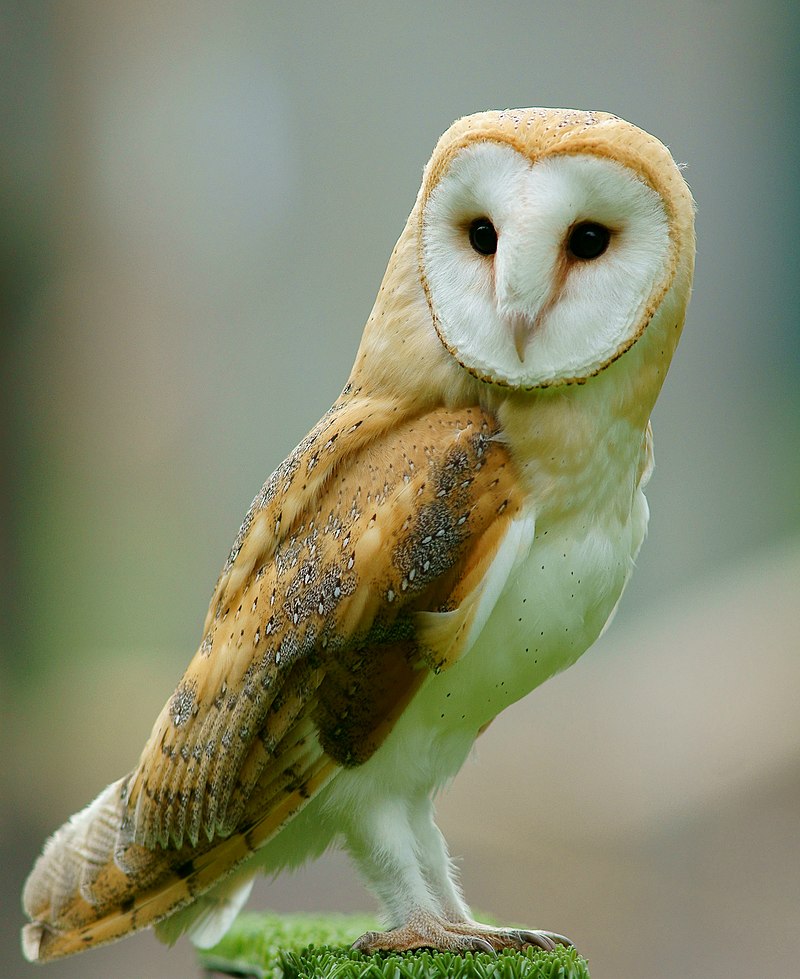
Barn owls are a beautiful and fascinating species of birds found around the world, with the exception of polar and desert regions, most of Indonesia and some Pacific Islands.
They have large eyes, thin legs and long wings that help them to hunt silently in low light conditions.
Their white colouring helps them blend into their surroundings making it easier for them to catch prey.
Barn owls are nocturnal hunters who use their impressive hearing capabilities to locate rodents moving within vegetation or tunnels beneath the ground.
They also feed on insects such as beetles, moths etc., which they can detect from high up in flight using their excellent vision even at night time.
The barn owl plays an important role in balancing ecosystems by controlling rodent populations which is why they should be protected wherever possible so that this vital service continues uninterruptedly.
Scientific classification:
| Kingdom | Animalia |
| Phylum | Chordata |
| Class | Aves |
| Order | Strigiformes |
| Family | Tytonidae |
| Genus | Tyto |
| Species | T. alba |
Also Featured In: Belarus Birds You Should Know, European Birds
17. White-Faced Whistling Duck
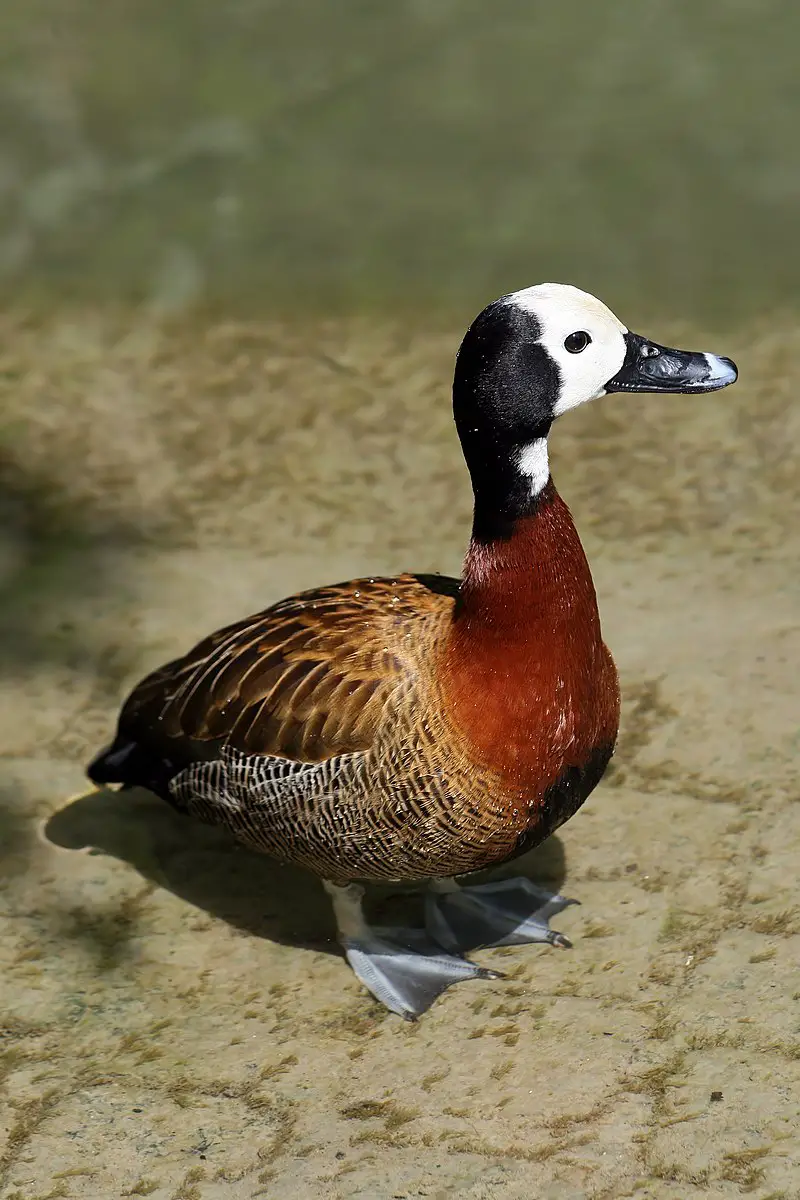
The white-faced whistling duck is a highly social bird native to sub-Saharan Africa and South America. It can be easily identified by its distinct three-note whistling call, as well as its long grey bill.
In the right conditions, it’s not uncommon to spot large flocks of these ducks numbering in the thousands at dawn – an incredible sight.
This species usually lives near bodies of water such as swamps or rivers where they feed on plant matter like grasses and grains which they graze on during the day.
When night falls, they fly off into trees nearby in search of safety from predators before returning to their feeding grounds when morning arrives again.
Scientific classification:
| Kingdom | Animalia |
| Phylum | Chordata |
| Class | Aves |
| Order | Anseriformes |
| Family | Anatidae |
| Genus | Dendrocygna |
| Species | D. viduata |
Also Featured In: Birds of Tanzania, Large Birds of Uganda
18. Grey Crowned Crane

The Grey Crowned Crane is a beautiful bird native to eastern and southern Africa. It belongs to the crane family, Gruidae, and its stunning plumage consists of grey feathers topped with golden crowns on their heads.
This species has become Uganda’s national bird due to its gracefulness in flight as well as for being an important part of local cultures across the continent.
The Grey Crowned Crane stands out from other birds not only because of its colorful appearance but also because it performs elaborate mating dances involving leaps, bows, throwing their head back or flapping wings while calling loudly – all in an effort to attract a mate.
In addition to these displays they are highly social animals that form strong bonds with one another and can live up 20 years if given proper care.
Scientific classification:
| Kingdom | Animalia |
| Phylum | Chordata |
| Class | Aves |
| Order | Gruiformes |
| Family | Gruidae |
| Genus | Balearica |
| Species | B. regulorum |
Also Featured In: Birds of South African, East African Birds
19. Hornbill
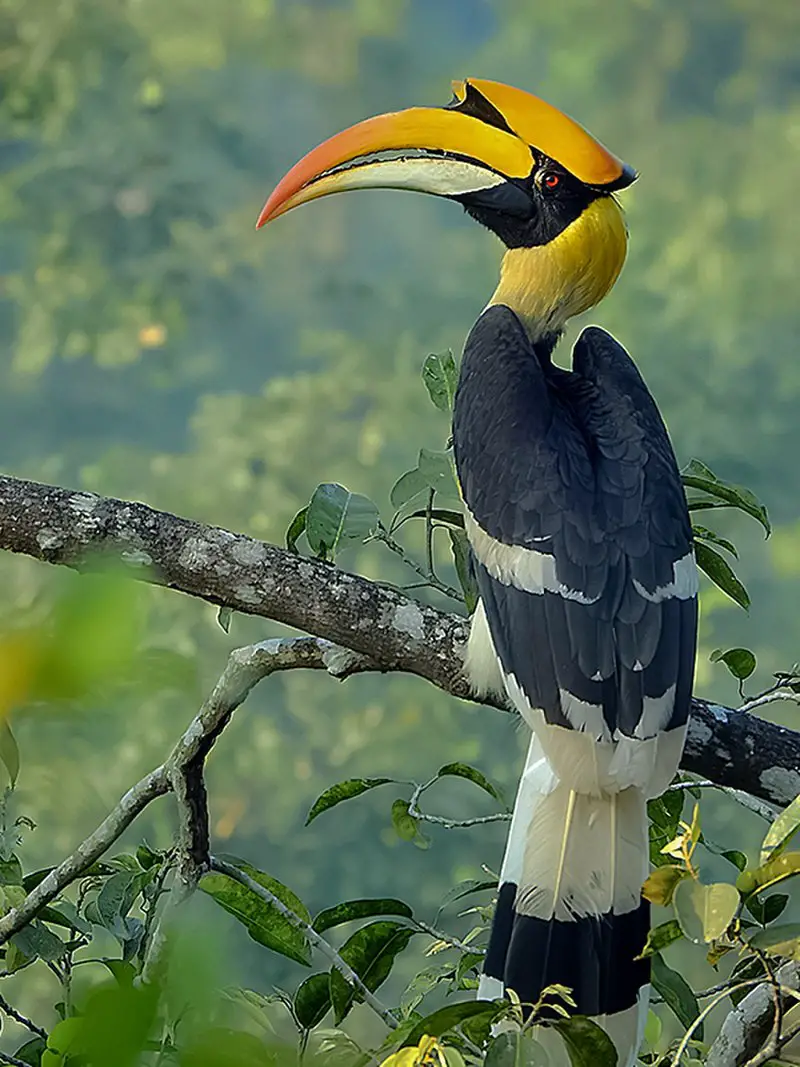
Hornbills are a tropical and subtropical bird species with characteristic long, curved bills. Their English and scientific names both refer to the shape of their bill which resembles that of a cow’s horn.
They have strong beaks for cracking open hard-shelled fruits as well as powerful wings for flying between trees or over great distances in search of food or mates.
Hornbills also feature beautiful plumage ranging from white to black feathers with yellow, brown, red and blue accents on the head, neck and back areas depending on the species.
In addition they often display brightly coloured casques – helmet like structures – atop their upper mandible adding further visual appeal to these majestic birds.
Scientific classification:
| Kingdom | Animalia |
| Phylum | Chordata |
| Class | Aves |
| Order | Bucerotiformes |
| Family | Bucerotidae Rafinesque, 1815 |
Also Featured In: Asian Birds, African Rainforest Birds
20. Blue Crane
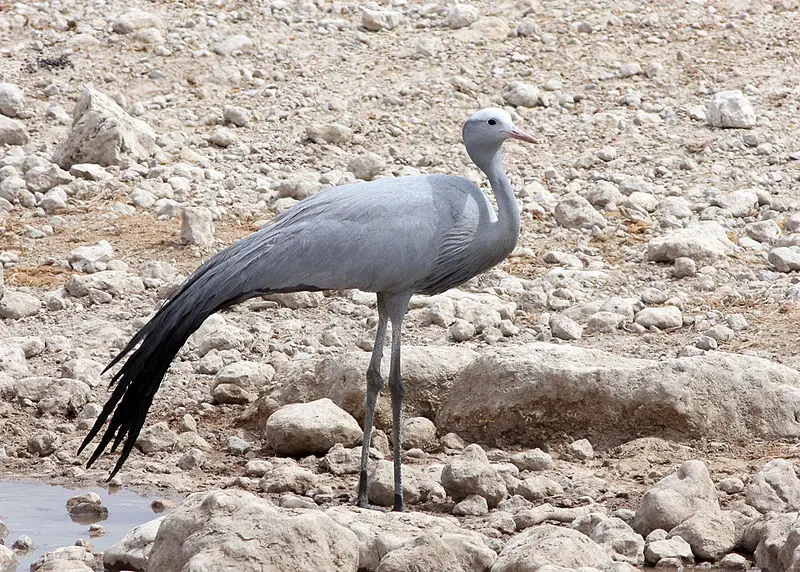
The Blue Crane is a majestic bird native to South Africa, and is the national bird of the country.
Standing at around 3 feet tall and with a wingspan up to 6 ft 7 inches, it has striking plumage that includes an ash-blue head and neck, white belly feathers, black wingtips and grey legs.
Unfortunately this species is listed as Vulnerable by The IUCN due to habitat loss caused by human development activities such as farming or mining.
Despite their vulnerability they are still seen in open habitats like grasslands where they feed on various seeds from plants growing there including wildflowers .
A beautiful sight indeed.
Scientific classification:
| Kingdom | Animalia |
| Phylum | Chordata |
| Class | Aves |
| Order | Gruiformes |
| Family | Gruidae |
| Genus | Grus |
| Species | G. paradisea |
21. Saddle-Billed Stork
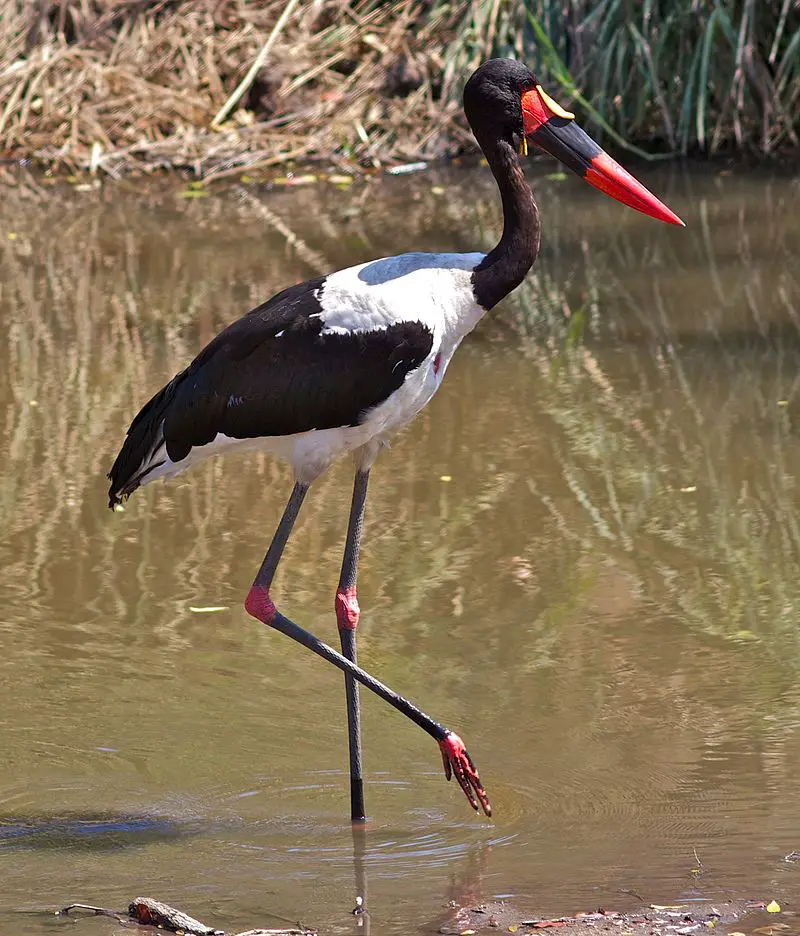
The Saddle-billed Stork is a large wading bird from the stork family, Ciconiidae. It can be found in sub-Saharan Africa and some parts of western Africa.
This majestic bird stands out with its striking features – it has an impressive bill that looks like a saddle and bright red legs which contrast against its white plumage on top.
The Saddle-billed Stork’s diet consists mostly of fish, frogs, aquatic invertebrates as well as small reptiles or mammals they come across while scavenging for food in wetland areas.
Sadly, this species is considered endangered in South Africa due to habitat loss and degradation caused by human activities such as drainage projects and agricultural expansion.
We must take action to protect these beautiful creatures before their numbers decrease further.
Scientific classification:
| Kingdom | Animalia |
| Phylum | Chordata |
| Class | Aves |
| Order | Ciconiiformes |
| Family | Ciconiidae |
| Genus | Ephippiorhynchus |
| Species | E. senegalensis |
Also Featured In: Birds that You’ll Find in Kruger national park, Birds You’ll Find in Kenya Safari
22. Stork
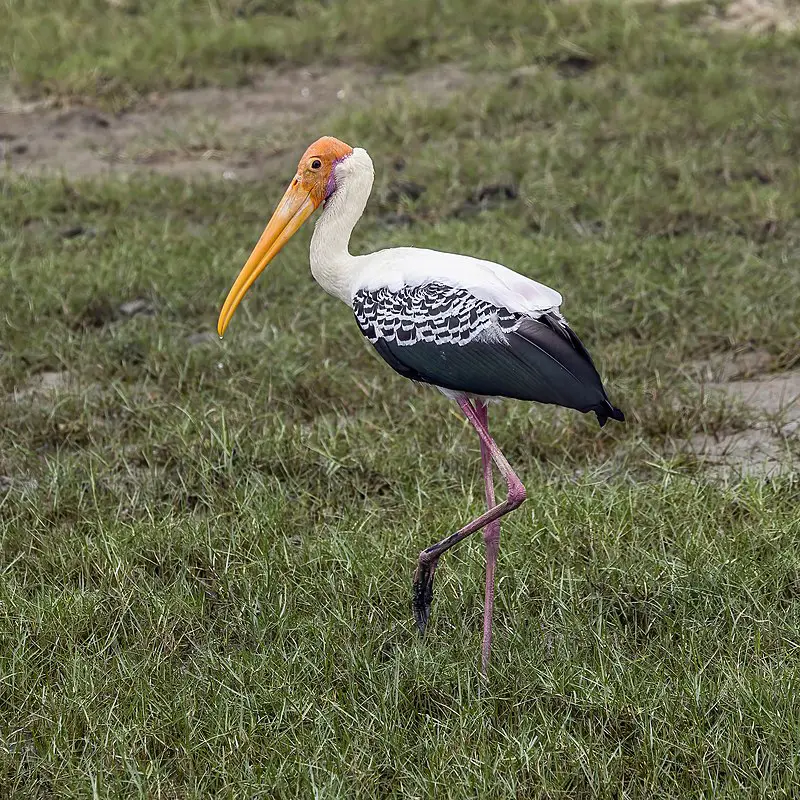
Storks are majestic birds, easily recognizable with their long necks and legs. They belong to the family Ciconiidae, making up the order Ciconiiformes.
Storks inhabit many areas around the world but generally prefer drier habitats than other wading birds like herons or ibises which have been moved to separate orders.
Despite being large in size they can be quite graceful in flight as well as when hunting for food such as insects, small mammals and reptiles near shallow waters.
During nesting season stork pairs build nests on high trees or platforms made of sticks and twigs where they lay eggs that hatch after about a month of incubation time by both parents taking turns sitting on them warmly until hatching day.
Scientific classification:
| Kingdom | Animalia |
| Phylum | Chordata |
| Class | Aves |
| Clade | Aequornithes |
| Order | Ciconiiformes Bonaparte, 1854[1] |
| Family | Ciconiidae J. E. Gray, 1840[1] |
Also Featured In: Native South Korean Birds, Water Birds Live around Us
23. Andean Condor
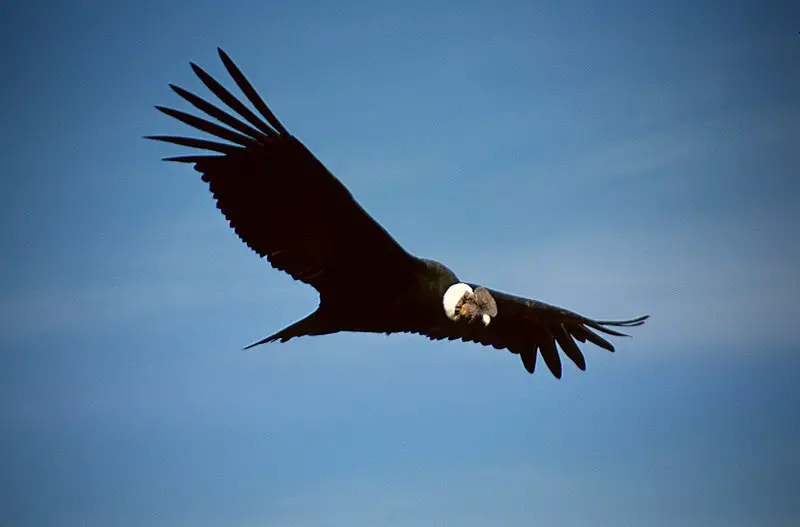
The Andean condor is a giant South American Cathartid vulture and the only member of its genus.
Found in the Andes mountains and along Pacific coasts, it is thought to be the largest flying bird on Earth by weight and wingspan with a maximum wingspan reaching up to 10 feet 10 inches (3.3 m) and weighing 33 lbs (15 kg).
It has mainly black plumage which helps keep it warm at high altitudes, while white patches adorn its head, neck, chest as well as underwing coverts.
Its powerful bill allows it to consume carrion efficiently while also being able to crack bones for nutrition when necessary.
The amazing flight capabilities of this majestic creature allow them soar through air thermals effortlessly; making them an impressive sight against clear blue skies.
Scientific classification:
| Kingdom | Animalia |
| Phylum | Chordata |
| Class | Aves |
| Order | Accipitriformes |
| Family | Cathartidae |
| Genus | Vultur Linnaeus, 1758 |
| Species | V. gryphus |
Also Featured In: Common Birds in Colombia, Aviary Birds You Should Know
24. Blue-Billed Curassow
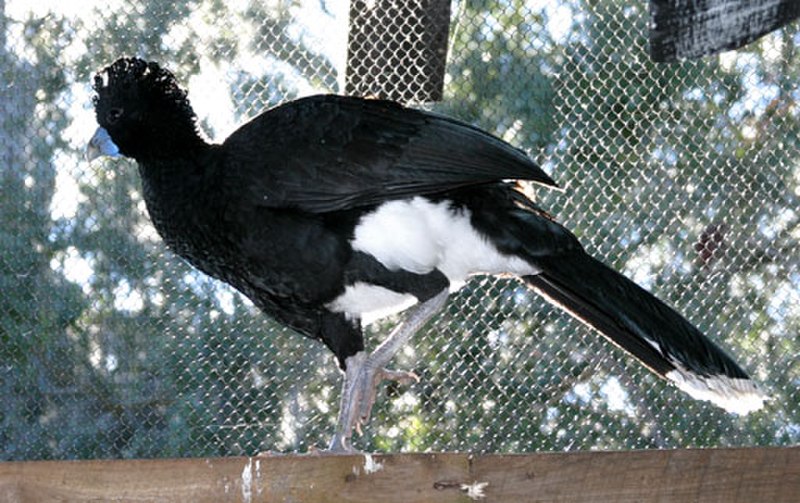
The Blue-billed Curassow is a species of bird that belongs to the family Cracidae, also known as chachalacas, guans and curassows.
Endemic to Colombia, this unique bird is monotypic; formerly it was considered a subspecies along with the Yellow-Knobbed Currasow which has since been classified separately.
The holotype for C. annulata has been identified as female Blue-Billed Currasow – another indication of its singularity.
With their striking deep blue bill and grey plumage they are certainly eye catching creatures that must be seen in their natural habitat to truly appreciate them in all their glory. They feed mainly on fruits but can include insects too when available.
Although threatened by deforestation these magnificent birds still roam freely through parts of Colombia’s forests giving us an insight into nature at its finest.
Scientific classification:
| Kingdom | Animalia |
| Phylum | Chordata |
| Class | Aves |
| Order | Galliformes |
| Family | Cracidae |
| Genus | Crax |
| Species | C. alberti |
25. American Flamingo
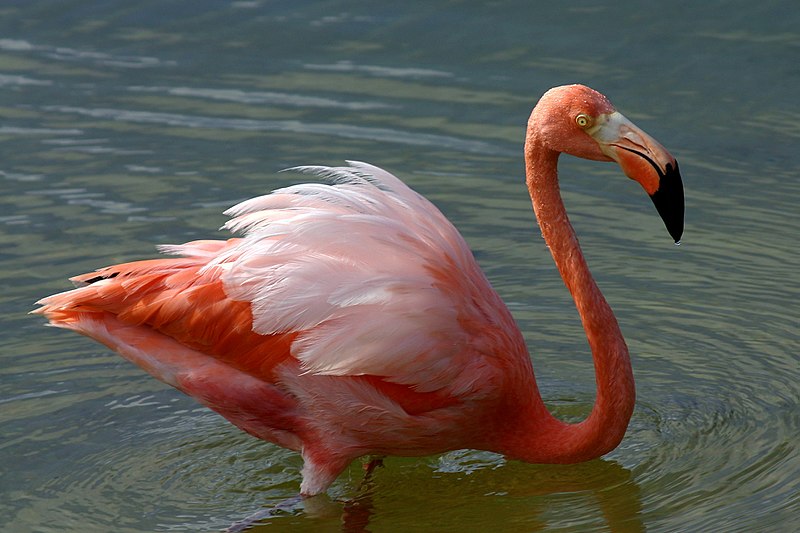
The American flamingo is a large species of bird found in the Neotropics. It has bright pink feathers and long legs, making it easily distinguishable from other species of flamingos.
The diet consists mostly of shrimp and small fish but they are also known to eat algae, aquatic insects, mollusks, crustaceans and seeds.
They live around coastal lagoons or salt ponds in colonies with thousands of birds nesting together on mud flats.
Flamingos build nests out of sticks that sit atop their feet as they wade through shallow waters looking for food during low tide periods when these areas become more accessible for feeding purposes.
These birds have an interesting courtship ritual involving neck stretching which looks like a dance to attract mates before breeding season begins in May-June each year leading to chicks hatching during July-August time period.
Scientific classification:
| Kingdom | Animalia |
| Phylum | Chordata |
| Class | Aves |
| Order | Phoenicopteriformes |
| Family | Phoenicopteridae |
| Genus | Phoenicopterus |
| Species | P. ruber |
Also Featured In: Galapagos Birds You Should Know, Birds that Make Mud Nests
26. Harpy Eagle
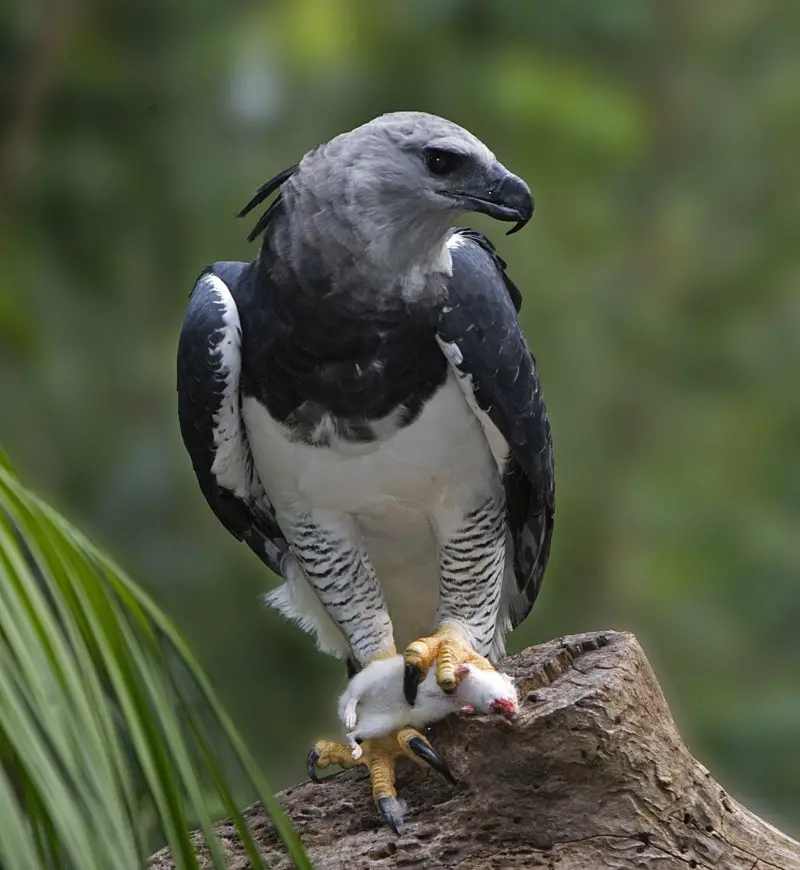
The Harpy Eagle is a magnificent bird of prey found in the tropical forests of Central and South America. It is the largest eagle on Earth, possessing an impressive wingspan that can reach up to 7 feet across.
Its powerful talons are its most distinguishing feature, being able to grasp even large animals such as monkeys or sloths with ease.
The majestic raptor has slate-gray feathers on its back and head which contrast against white undersides and yellow legs.
These birds live alone for much of their life but will come together during breeding season when they construct elaborate nests high off the ground in tall trees.
People have long been fascinated by this species’ impressive size and strength—it truly deserves its nickname as “the lord of skies”.
Scientific classification:
| Kingdom | Animalia |
| Phylum | Chordata |
| Class | Aves |
| Order | Accipitriformes |
| Family | Accipitridae |
| Subfamily | Harpiinae |
| Genus | Harpia Vieillot, 1816 |
| Species | H. harpyja |
Also Featured In: Common Carnivore Birds,
27. Trumpeter Swan
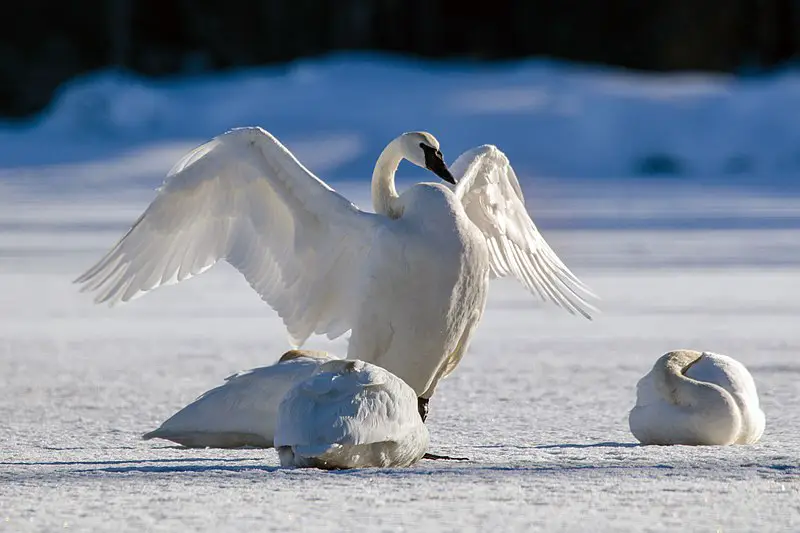
The majestic Trumpeter Swan is the largest native waterfowl in North America, with a wingspan of up to 8 feet.
Found throughout Canada and parts of the United States, this beautiful bird can live for up to 20 years.
It has black legs and bill that are tipped yellow as well as snow-white feathers that help it stand out in its natural habitat.
The trumpeter swan’s diet consists mainly of aquatic vegetation such as roots, tubers, stems, leaves and seeds which they find by wading into shallow waters or grazing on land.
These birds form strong family bonds; both parents raise their young together until they reach adulthood at four years old.
Through conservation efforts these incredible creatures have been brought back from near extinction giving us all something special to appreciate.
Scientific classification:
| Kingdom | Animalia |
| Phylum | Chordata |
| Class | Aves |
| Order | Anseriformes |
| Family | Anatidae |
| Genus | Cygnus |
| Species | C. buccinator |
Also Featured In: Common Birds in Canada, Birds Live in Arkansas
28. Humboldt Penguin
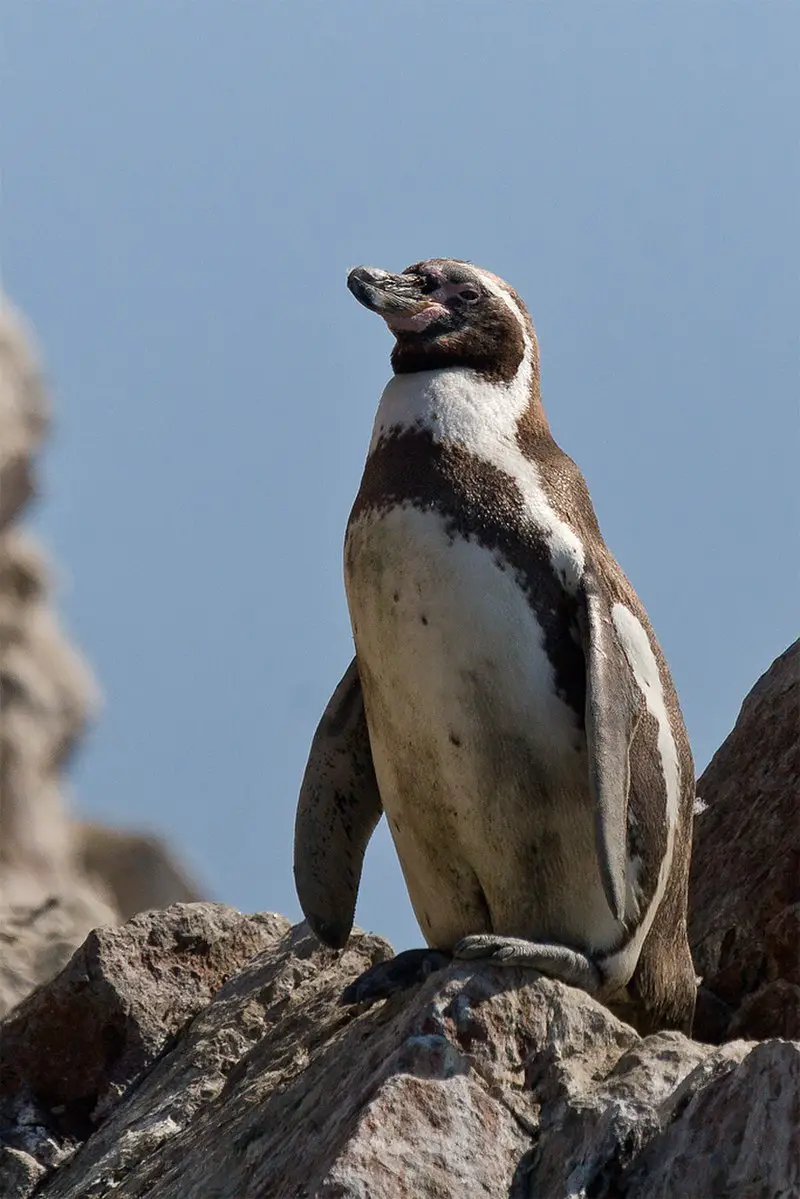
The Humboldt Penguin is a medium-sized bird that resides in South America, mainly along the coastal regions of Peru. It belongs to the same family as African Penguins, Magellanic Penguins and Galapagos Penguins.
The species was named after Alexander von Humboldt, an explorer who first discovered it during his travels. With its black and white plumage, they are easily recognizable by their distinctive pink tufts on their face and feet.
Despite being listed as vulnerable due to habitat loss and hunting for food or feathers, these penguins have adapted well with human presence around them; making colonies close to fishing villages near rocky coasts where there is abundant shelter from predators like sea lions and seals.
They feed primarily on anchovies but also eat other fish such as sardines if available nearby.
Conservation efforts must be taken soon so we can protect this unique creature from extinction.
Scientific classification:
| Kingdom | Animalia |
| Phylum | Chordata |
| Class | Aves |
| Order | Sphenisciformes |
| Family | Spheniscidae |
| Genus | Spheniscus |
| Species | S. humboldti |
Also Featured In: Most Unique Birds in Peru,
29. Parrots
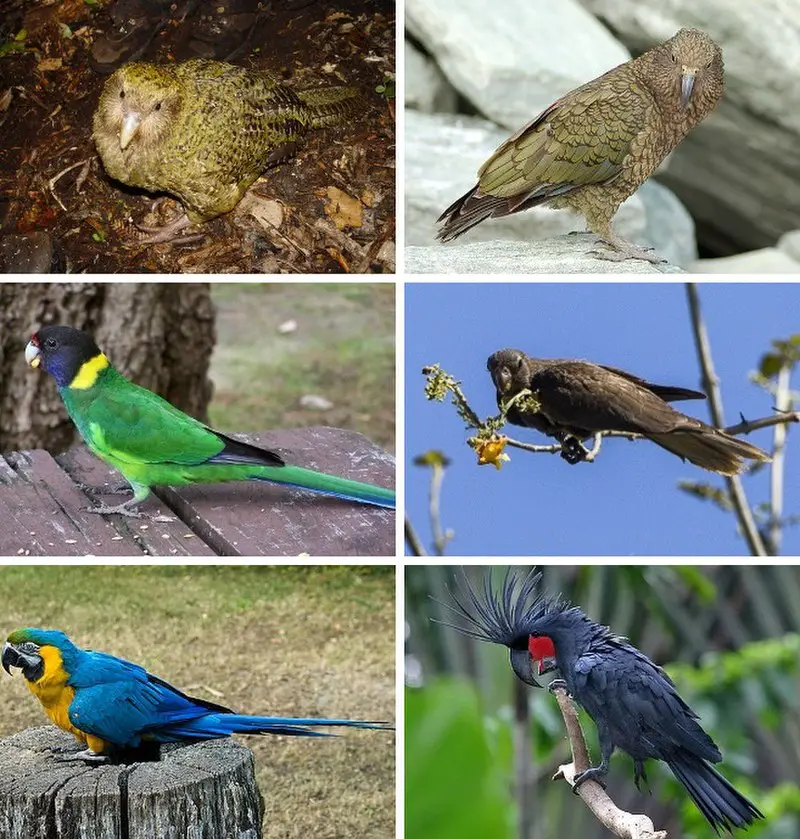
Parrots are a diverse group of birds, found in tropical and subtropical regions. They make up the order Psittaciformes, which is divided into three superfamilies: “true” parrots (Psittacoidea), cockatoos (Cacatuoidea) and New Zealand Parrots (Strigopoidea).
Many species have brightly colored feathers that can be red, yellow or blue. Their strong curved bills allow them to feed on fruits, nuts and seeds.
Parrot behavior ranges from playful to aggressive depending on their environment and socialization with humans.
Some even learn human words. As beloved pets they bring joy to many households around the world though it’s important for owners to understand how best to care for these intelligent creatures so as not to cause distress or harm.
Scientific classification:
| Kingdom | Animalia |
| Phylum | Chordata |
| Class | Aves |
| Clade | Psittacopasserae |
| Order | Psittaciformes Wagler, 1830 |
Also Featured In: Most common birds in Australia, Italian Birds You Should Know
30. Emu
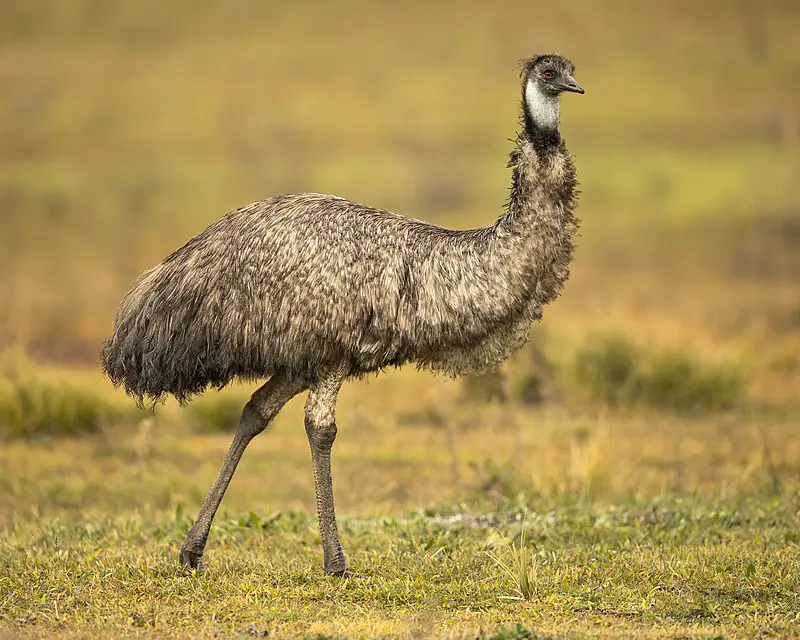
The Emu is a large bird native to Australia, and the only living species of its genus. It stands as the second-tallest living bird in the world after ostriches.
These birds are largely flightless but can run fast over short distances with their long legs, allowing them to escape from predators easily.
They have brown feathers that help camouflage them on open grasslands and wooded areas they inhabit throughout mainland Australia.
Unfortunately, three subspecies of emus on Kangaroo Island, King Island and Tasmania became extinct soon after European settlers arrived in Australia due to hunting or habitat destruction caused by human activities such as logging or agriculture development.
Despite this decline in population numbers, these impressive creatures continue to thrive across much of continental Australia today.
Scientific classification:
| Kingdom | Animalia |
| Phylum | Chordata |
| Class | Aves |
| Infraclass | Palaeognathae |
| Order | Casuariiformes |
| Family | Casuariidae |
| Genus | Dromaius |
| Species | D. novaehollandiae |
Also Featured In: Most Common Birds in Oceania,
31. Laughing Kookaburra
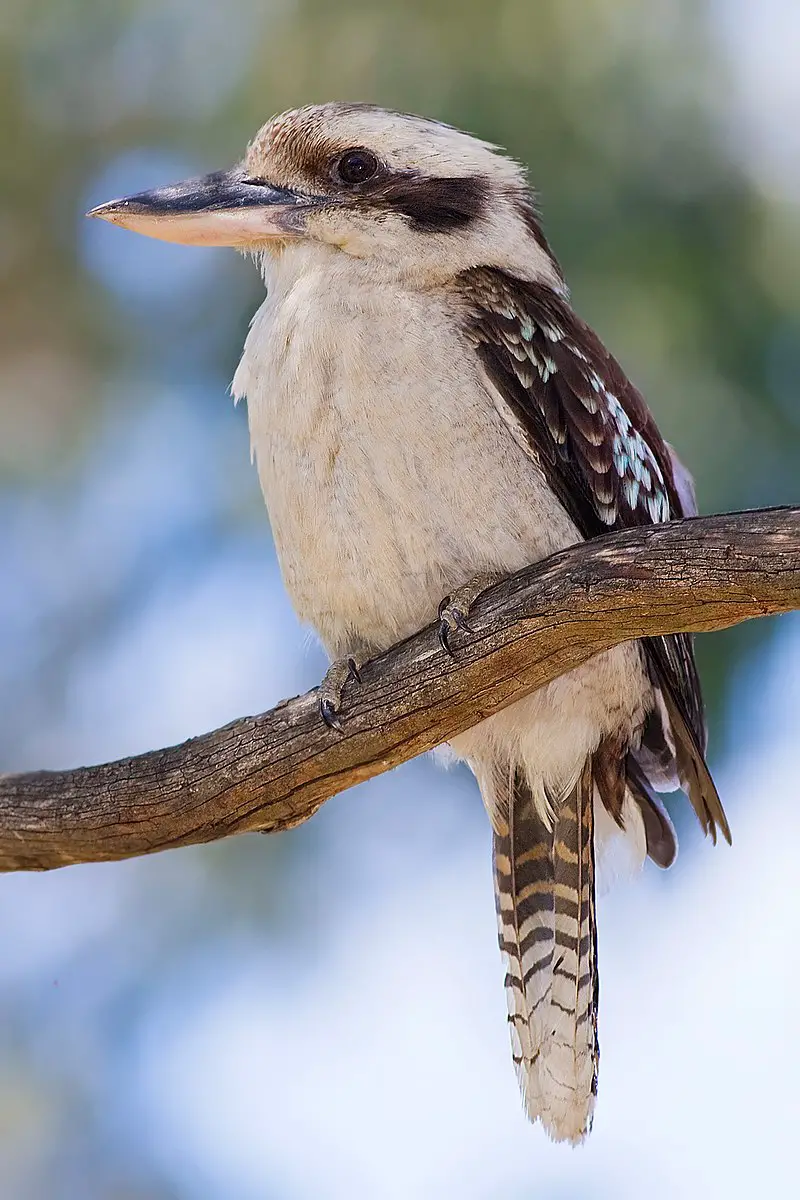
The Laughing Kookaburra is a beautiful bird with distinct features. It has a whitish head and brown eye-stripe, along with an upper body that is predominantly dark brown.
On its wings are mottled light blue patches which make it stand out even more. Its underparts are cream white while its tail is barred in rufous and black colours.
Male and female birds have the same plumage, making them easy to identify as belonging to this species of kingfisher subfamily Halcyoninae.
They can be found living around woodlands or open forests throughout eastern Australia, where they feed on small reptiles, insects or amphibians by swooping down from a perch above them before carrying their prey back up again for consumption.
The sound of their loud distinctive call – “koo-kaa-brrr” – brings joy to many Australians who appreciate these wonderful creatures inhabiting our land.
Scientific classification:
| Kingdom | Animalia |
| Phylum | Chordata |
| Class | Aves |
| Order | Coraciiformes |
| Family | Alcedinidae |
| Subfamily | Halcyoninae |
| Genus | Dacelo |
| Species | D. novaeguineae |
Also Featured In: Birds that Live around Brisbane, Birds that Live around Victoria
32. Rainbow Lorikeet
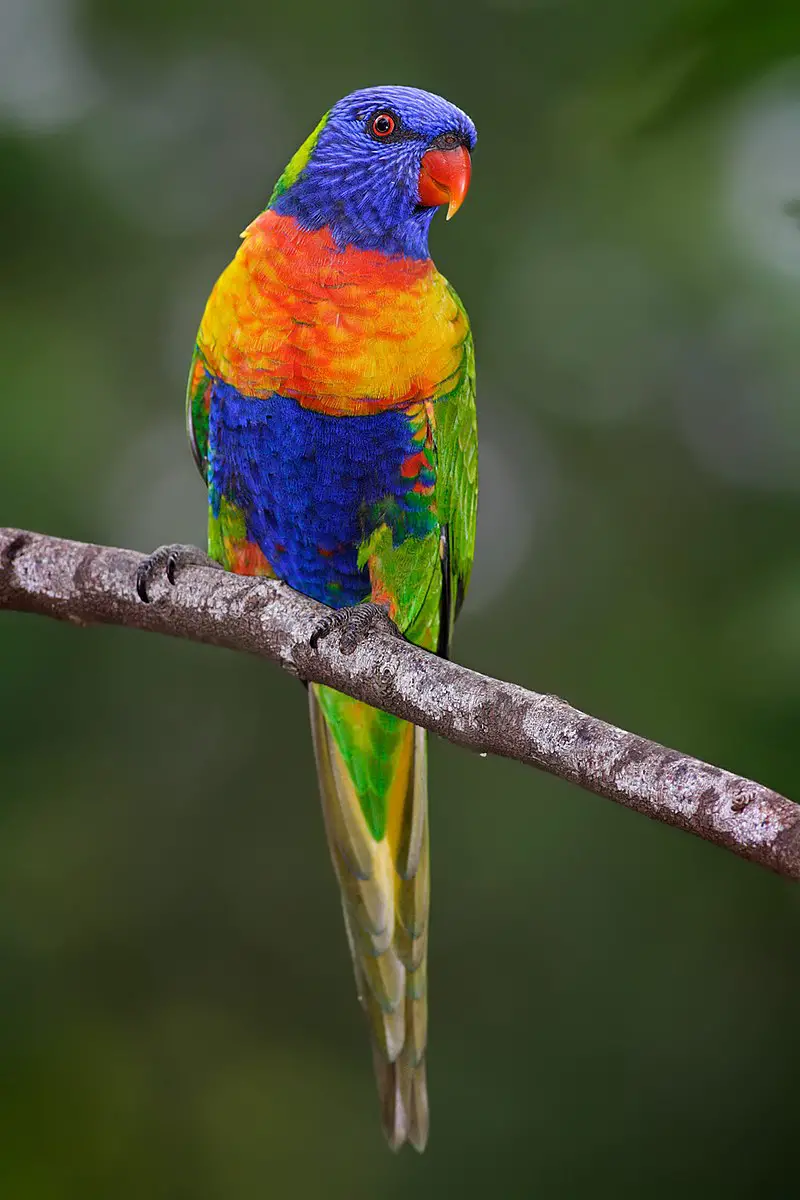
The Rainbow Lorikeet is a brightly coloured parrot native to Australia. It inhabits rainforests, coastal bushlands and woodland areas along the eastern seaboard from northern Queensland to South Australia.
These birds have an unmistakable bright rainbow plumage of blue, red and yellow feathers which make them easy to recognise in their natural environment.
They are also known for their distinctive call – often described as sounding like ‘kikiki-kyu’.
Six related species were once considered subspecies of the Rainbow Lorikeet but these days they are recognised separately due to differences in size, colouration and behaviour.
Despite being introduced elsewhere such as New Zealand, Hawaii or California they remain largely confined within their original range in Australia – where they can be seen soaring through the air or drinking nectar from flowers with its long tongue.
Scientific classification:
| Kingdom | Animalia |
| Phylum | Chordata |
| Class | Aves |
| Order | Psittaciformes |
| Family | Psittaculidae |
| Genus | Trichoglossus |
| Species | T. moluccanus |
Also Featured In: Birds that Live Near Adelaide, Queensland Birds You Should Know
33. Kookaburra
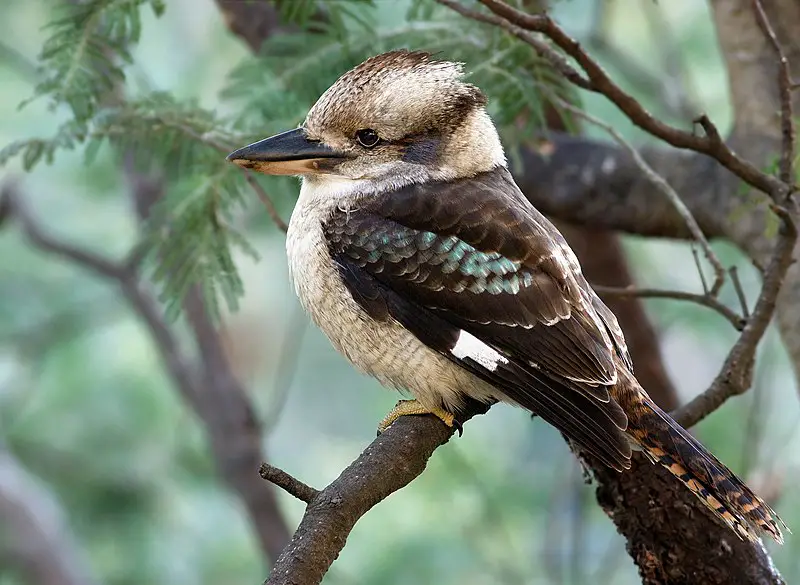
Kookaburras are the kingfishers of Australia and New Guinea. They measure between 28-47 cm in length, weighing around 300g. These birds have a distinctive call that sounds like loud laughter – this is why they’re called ‘Laughing Kookaburra’.
It’s become a popular sound effect for many situations involving Australia. Their vocalizations can be heard from up to 2km away and consist of both single notes or repetitive series.
They eat small insects, lizards, frogs, snakes and other small animals as well as sometimes fruits too.
In captivity their lifespans can reach over 20 years old but usually not more than 10 in the wild due to predators such as cats and foxes preying on them.
Scientific classification:
| Kingdom | Animalia |
| Phylum | Chordata |
| Class | Aves |
| Order | Coraciiformes |
| Family | Alcedinidae |
| Subfamily | Halcyoninae |
| Genus | Dacelo Leach, 1815 |
34. Budgerigar
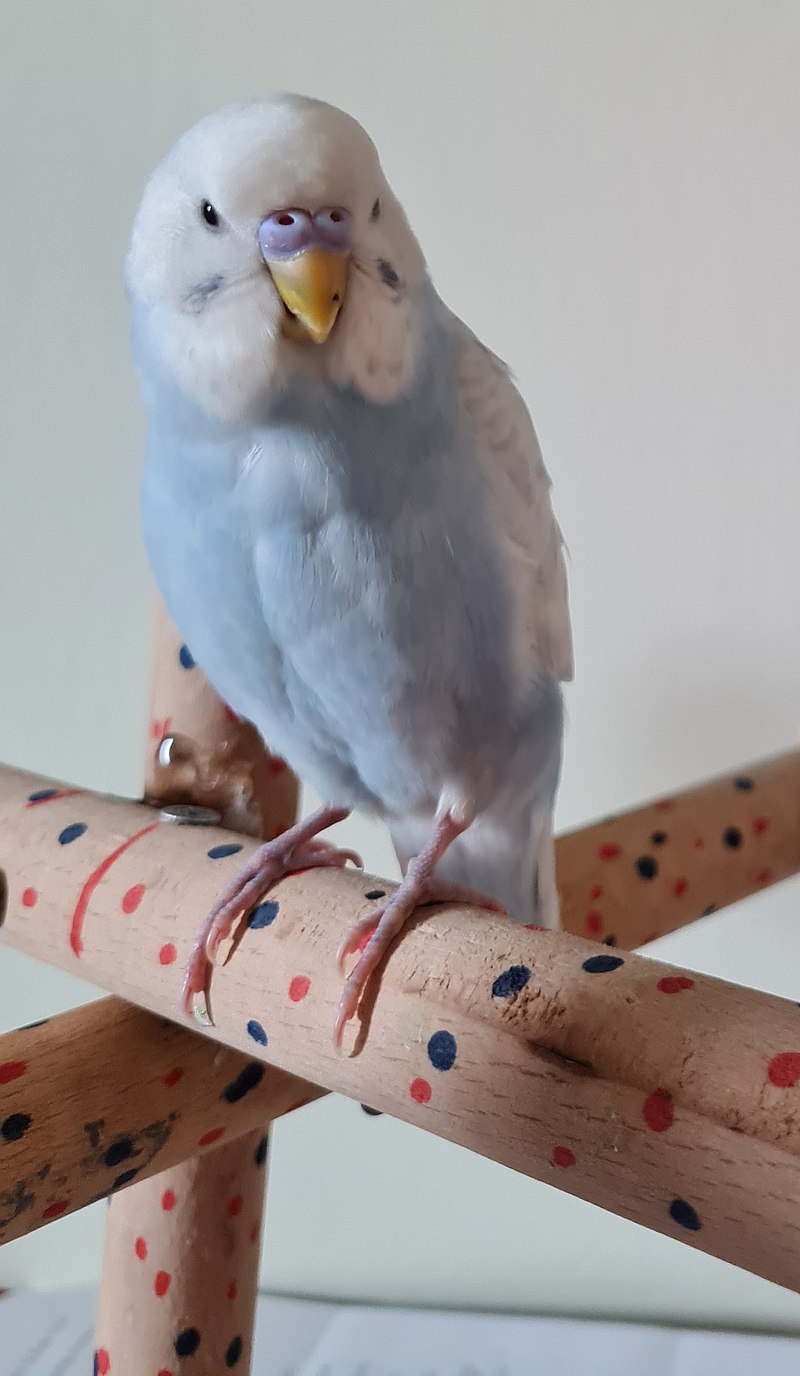
The Budgerigar is a small and beautiful parrot, commonly known as the common parakeet or shell parakeet. It has an average length of 18 cm with a long tail and primarily green-yellow coloration along its body.
Black stripes can be found on their wings and cheeks while they have white rings around their eyes giving them a unique look.
These birds are mainly seed eaters but also love fruits, vegetables, nuts and other grains in captivity.
They are highly social creatures that live in large flocks in the wild but enjoy companionship when kept as pets too.
Their ability to mimic human speech makes them great conversation partners for those living alone who need some company.
Scientific classification:
| Kingdom | Animalia |
| Phylum | Chordata |
| Class | Aves |
| Order | Psittaciformes |
| Family | Psittaculidae |
| Subfamily | Loriinae |
| Tribe | Melopsittacini |
| Genus | Melopsittacus Gould, 1840 |
| Species | M. undulatus |
Also Featured In: Small Birds that Live in New South Wales, Green Birds Commonly Found in Florida
35. Southern Cassowary
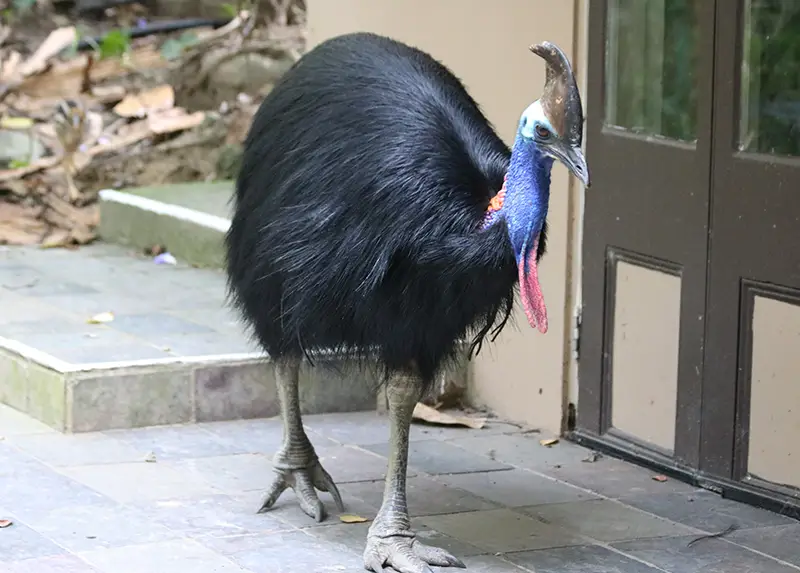
The southern cassowary is a large flightless black bird that can be found in Australia and New Guinea. It belongs to the ratite family, which consists of birds such as emus, ostriches, rheas and kiwis.
The southern cassowary has two wattles (fleshy protrusions) on its neck; this makes it stand out from other species of cassowaries since they usually only have one wattle.
This bird stands at an impressive height of up to 1.5m tall and weighs around 60kg.
They are omnivorous animals but favour fruits over anything else, although they also eat insects, small vertebrates like lizards or snakes and fungi too.
Southern Cassowaries play an important role in maintaining healthy ecosystems by dispersing seeds through their droppings – thus helping forests regenerate naturally.
Scientific classification:
| Kingdom | Animalia |
| Phylum | Chordata |
| Class | Aves |
| Infraclass | Palaeognathae |
| Order | Casuariiformes |
| Family | Casuariidae |
| Genus | Casuarius |
| Species | C. casuarius |
Also Featured In: Birds Typically Found in Australian Rainforest, Birds of Far North Queensland
36. Black Vulture
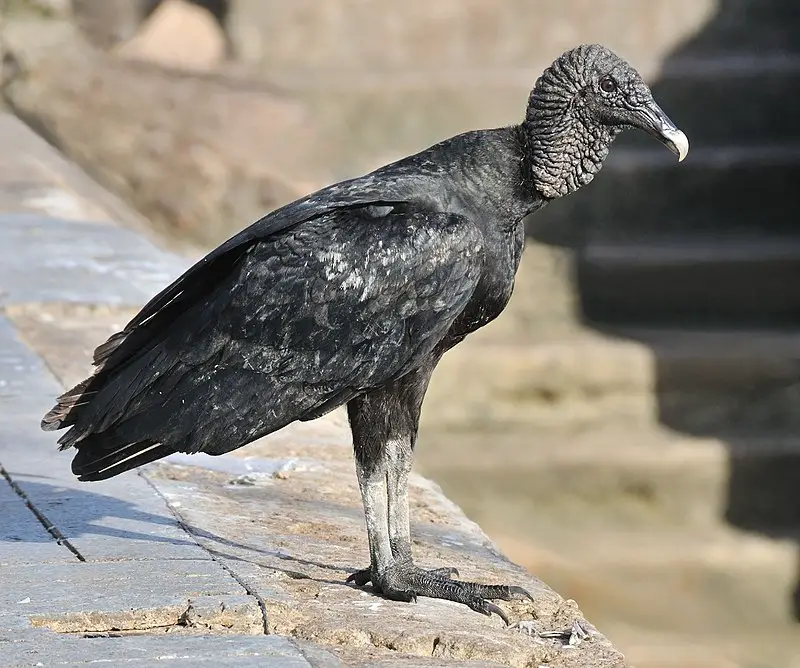
The black vulture is a common and widespread species of New World Vultures, found in the northeastern United States all the way to Peru, Central Chile and Uruguay.
It’s distinctive appearance has earned it many nicknames such as zopilote, urubu or gallinazo.
This medium-sized bird has mainly black plumage with some white markings on its wings and head; also featuring a long bill for scavenging carrion from carcasses.
Despite being able to fly up high due to its broad wingspan, it prefers keeping close to ground level when searching for food items like dead fish or small mammals that are available near human settlements.
As an apex predator they play an important role in nature by helping keep their environment clean while providing other animals with sustenance through their leftovers.
Scientific classification:
| Kingdom | Animalia |
| Phylum | Chordata |
| Class | Aves |
| Order | Accipitriformes |
| Family | Cathartidae |
| Genus | Coragyps |
| Species | C. atratus |
Also Featured In: Most Common Birds Found in Chile, Birds that Live around Central Florida
37. Red-Tailed Hawk
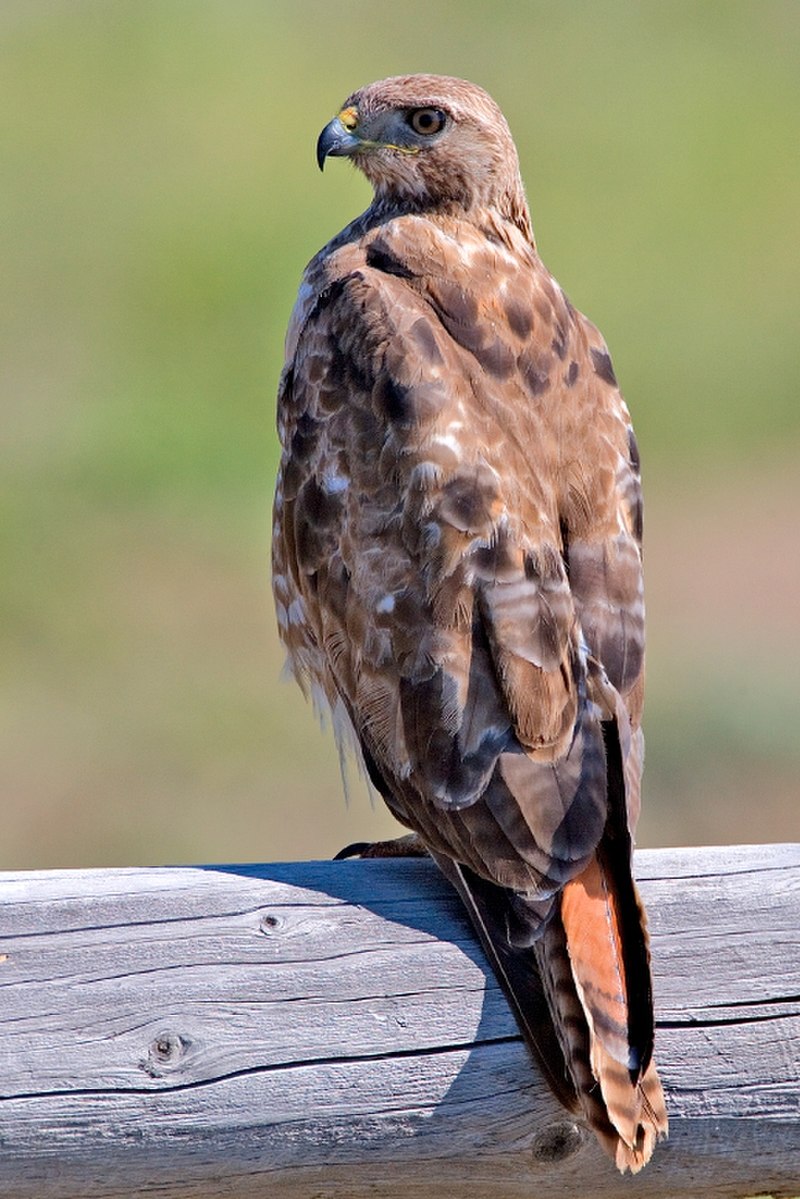
The Red-tailed Hawk is a majestic bird of prey with its distinctive red tail. It can be found throughout North America, from Alaska in the north to Panama and the West Indies in the south.
This species belongs to Buteo genus, which makes it one of most common raptors on earth.
These hawks mainly hunt small mammals such as rabbits or squirrels but also feed on reptiles and birds during migration season.
Unlike other predator birds, they prefer open areas for hunting like fields or grasslands rather than dense forests.
They build their nests high up on trees where they stay all year long unless disturbed by humans or animals nearby.
Their presence has become an iconic part of American culture due to their frequent sightings around homes and parks alike making them beloved creatures among people everywhere.
Scientific classification:
| Kingdom | Animalia |
| Phylum | Chordata |
| Class | Aves |
| Order | Accipitriformes |
| Family | Accipitridae |
| Genus | Buteo |
| Species | B. jamaicensis |
Also Featured In: Dominican Republic birds, New Hampshire Birds You Should Know
38. Spotted Thick-Knee
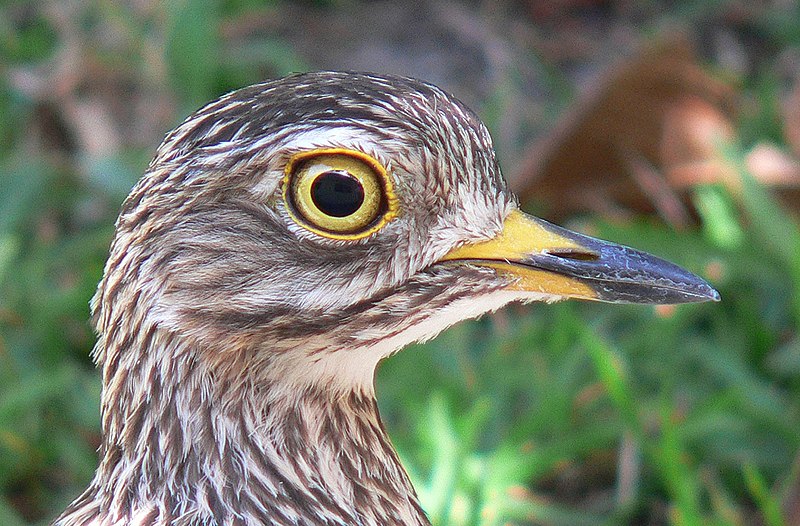
The spotted thick-knee is a wader in the family Burhinidae, native to tropical regions of central and southern Africa.
It stands at 45.5 cm tall with long legs, brown and white speckled plumage that provides excellent camouflage amongst grasslands or other similar habitats.
This species feeds mainly on insects but can also be found eating small reptiles and amphibians as well as some fruit when available.
They are nocturnal creatures who spend their days hidden away from predators in dense vegetation waiting for nightfall before venturing out to hunt for food.
The breeding season takes place between October to February during which time pairs form monogamous relationships lasting up until the next nesting period begins again each year.
This bird has an incredible ability to remain undetected by its predators allowing it thrive despite its vulnerable nature making it an important part of many African ecosystems today.
Scientific classification:
| Kingdom | Animalia |
| Phylum | Chordata |
| Class | Aves |
| Order | Charadriiformes |
| Family | Burhinidae |
| Genus | Burhinus |
| Species | B. capensis |
Also Featured In: Oman Birds, Birds that Live in Benin
39. Roseate Spoonbill
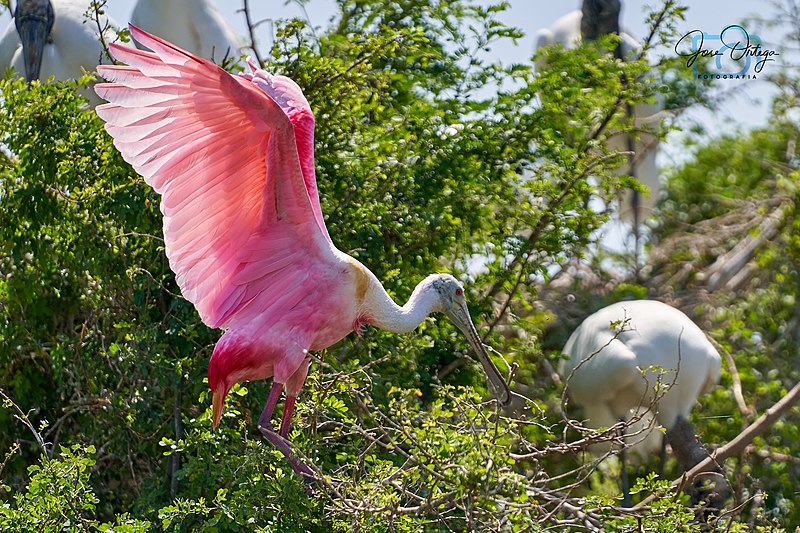
The Roseate Spoonbill is a beautiful and majestic bird found in both North and South America.
It belongs to the ibis family, Threskiornithidae, and its vibrant pink colour comes from canthaxanthin pigment derived from their diet of crustaceans like shrimp.
Sadly plume hunting has almost driven this species close to extinction during the 18th and 19th centuries but fortunately it’s making a comeback due to conservation efforts made by dedicated wildlife organisations.
Its large spoon-like bill helps them filter out food sources such as small fish or frogs from shallow water areas while they wade through mudflats with their long legs looking for something tasty.
With its unique appearance, graceful wingspan amd impressive flight capabilities, the Roseate Spoonbill is an incredibly photogenic animal that will captivate any viewers attention who happen to be lucky enough witness it in all its glory.
Scientific classification:
| Kingdom | Animalia |
| Phylum | Chordata |
| Class | Aves |
| Order | Pelecaniformes |
| Family | Threskiornithidae |
| Genus | Platalea |
| Species | P. ajaja |
Also Featured In: Costa Rica Birds, Birds You’ll Find in South Texas
40. Spectacled Owl
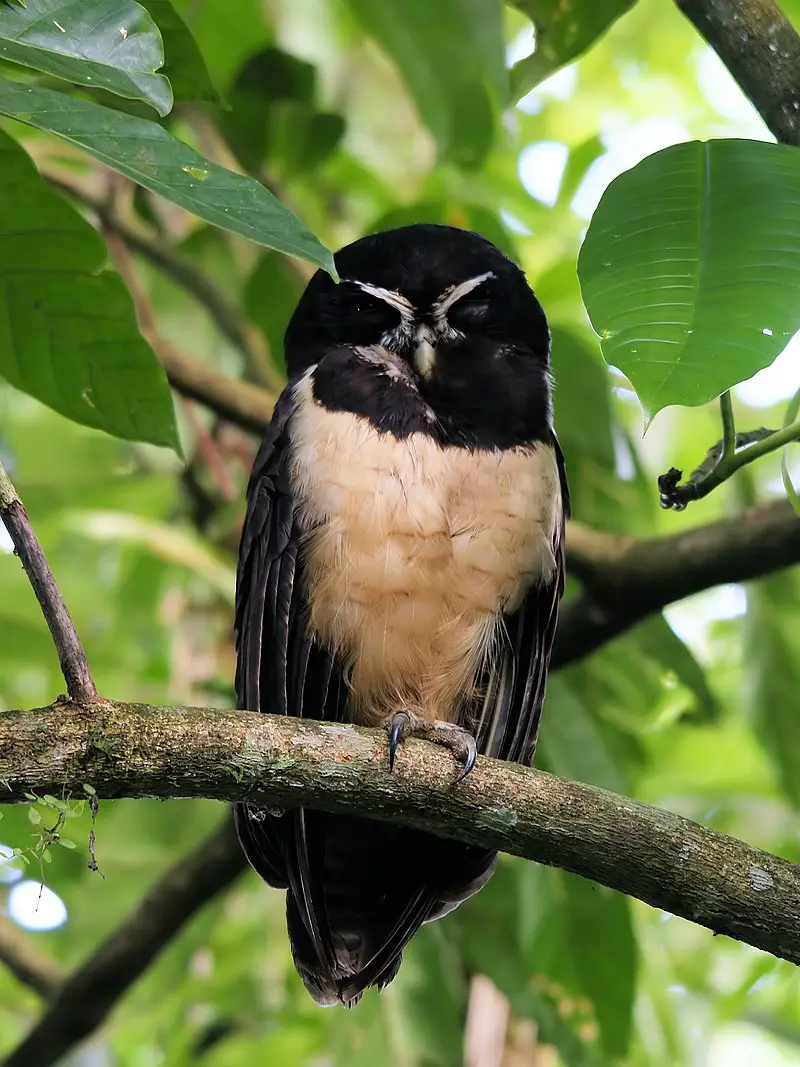
The Spectacled Owl is a large tropical owl that breeds in forests from southern Mexico, Trinidad and Central American countries to Southern Brazil, Paraguay and Argentina.
It has six subspecies with one of them sometimes considered as a separate species called the Short-Browed or Brown Spectacled Owl.
The bird’s body is covered by an array of feathers which are typically dark brown streaked with lighter shades marking its eyes like spectacles; this gives it its name.
Its call could be described as a series of hoots followed by shrieks making it easily distinguishable amongst other owls.
This nocturnal predator feeds mostly on small mammals such as mice while larger prey items include frogs, bats and even birds.
Scientific classification:
| Kingdom | Animalia |
| Phylum | Chordata |
| Class | Aves |
| Order | Strigiformes |
| Family | Strigidae |
| Genus | Pulsatrix |
| Species | P. perspicillata |
Also Featured In: Panama Birds,
41. Eastern Screech Owl
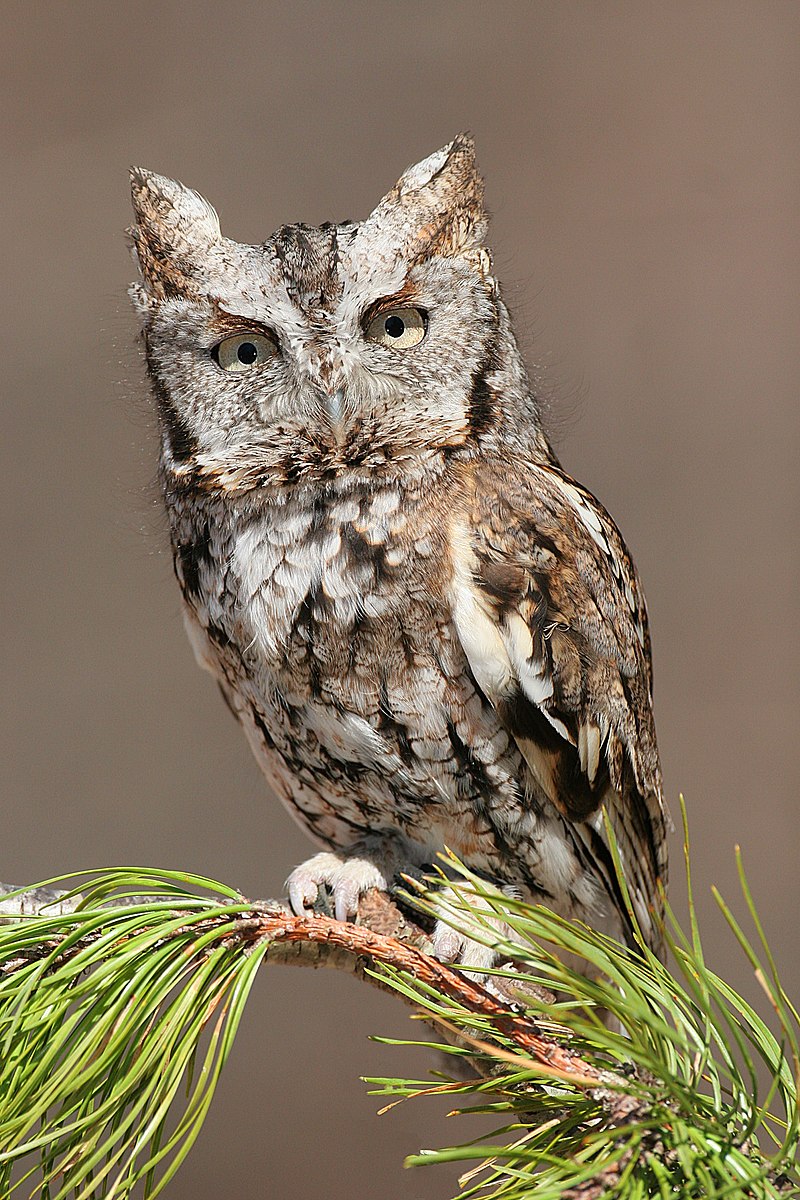
The Eastern screech owl is a small nocturnal bird native to most wooded areas in Mexico and Canada. It has adapted well to human development, making it relatively common in East North America.
This species is known for its unique call which often sounds like a horse whinnying or an electronic beep.
Its feathers are mainly grey with brown bars, but they can also range from red-brown to blackish-grey depending on the individual bird’s location.
They feed primarily on insects and other small animals such as mice and lizards that live near their nest sites at night.
The eastern screech owl is an amazing creature adapting well to humans while still managing to stay hidden under cover of darkness.
Scientific classification:
| Kingdom | Animalia |
| Phylum | Chordata |
| Class | Aves |
| Order | Strigiformes |
| Family | Strigidae |
| Genus | Megascops |
| Species | M. asio |
Also Featured In: Georgia Birds, Long Island Birds You Should Know
42. Penguins
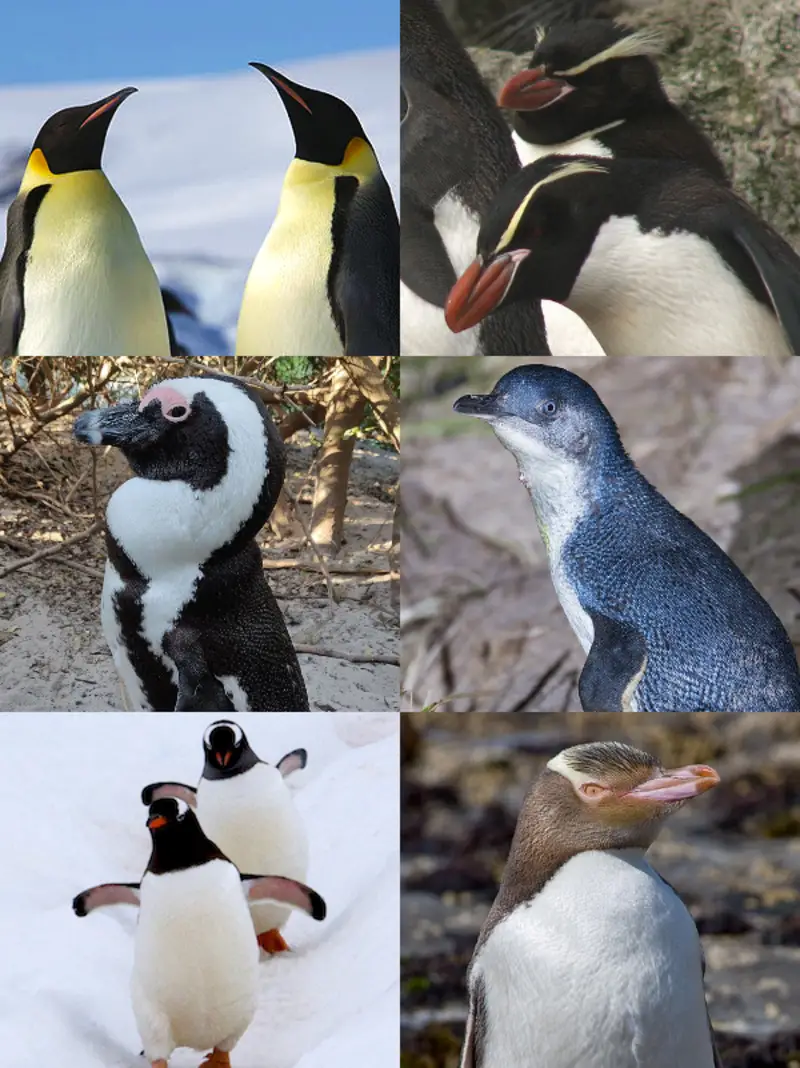
Penguins are an amazing species of aquatic birds that live mainly in the Southern Hemisphere. They have a unique plumage, which is black and white countershaded to aid them while swimming in the water.
Penguins feed mostly on krill, small crustaceans found near Antarctica. These remarkable creatures can’t fly but they compensate by being excellent swimmers due to their flippers-like wings which help them move faster underwater.
All this makes penguins one of nature’s most fascinating animals – not just for kids.
Scientific classification:
| Kingdom | Animalia |
| Phylum | Chordata |
| Class | Aves |
| Clade | Austrodyptornithes |
| Order | Sphenisciformes Sharpe, 1891 |
| Family | Spheniscidae Bonaparte, 1831 |
Also Featured In: Antarctica Birds, Birds You’ll Find in the Sea
43. California Condor
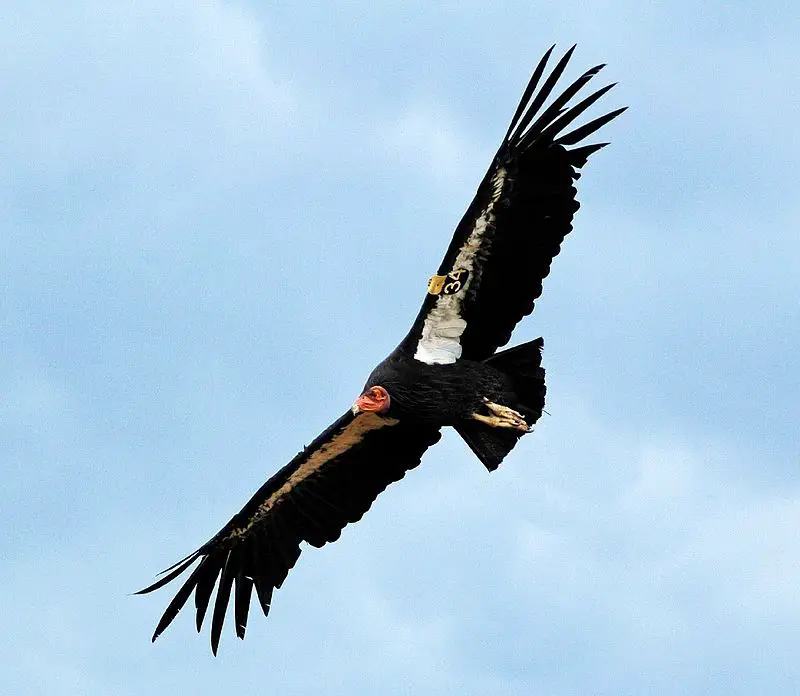
The California condor is a majestic bird, being the largest North American landbird. It was sadly pushed to extinction in the wild back in 1987 when all remaining individuals were captured.
Since then, conservation efforts have allowed for reintroductions of these birds into areas such as northern Arizona and southern Utah, including Zion National Park and Grand Canyon area; coastal mountains of California; and northern Baja California.
The species has been given plenty of protection with numerous laws created to protect it from human interference or disturbance while also helping boost its population size through captive breeding programs.
Thanks to this effort we can now enjoy seeing this incredible species flying across our skies once more.
Scientific classification:
| Kingdom | Animalia |
| Phylum | Chordata |
| Class | Aves |
| Order | Accipitriformes |
| Family | Cathartidae |
| Genus | Gymnogyps |
| Species | G. californianus |
Also Featured In: Common Californian Birds, Birds that Live in the Grand Canyon National Park
44. Columbidae
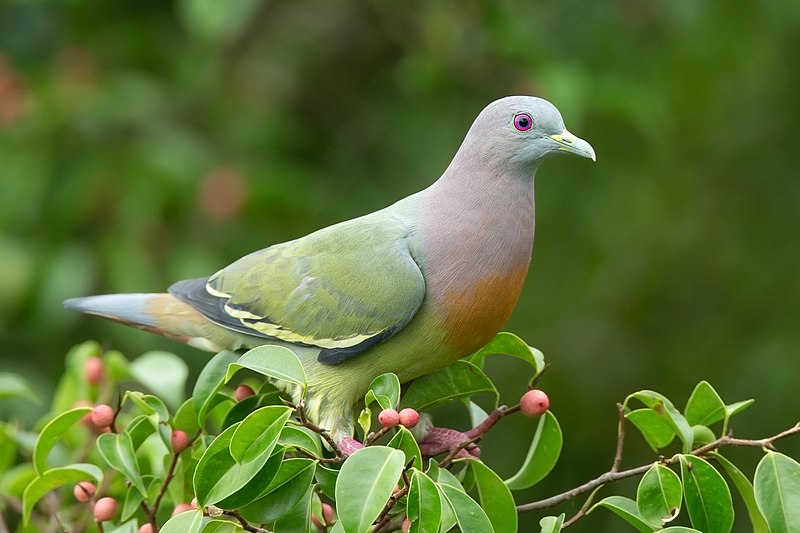
Columbidae is a bird family that includes both doves and pigeons. These birds are characterized by their stout bodies, short necks, and small slender bills with fleshy ceres in some species.
They feed mainly on seeds, fruits, and plants found all around the world but have the greatest variety in Indomalayan and Australasian regions.
Columbidae have an unmistakable soft cooing sound which makes them one of the most beloved avian families worldwide – especially among city dwellers.
Whether it be feeding time or just hearing their soothing call throughout nature walks; these birds will remain a favourite for many more years to come.
Scientific classification:
| Kingdom | Animalia |
| Phylum | Chordata |
| Class | Aves |
| Clade | Columbimorphae |
| Order | Columbiformes Latham, 1790 |
| Family | Columbidae Leach, 1820 |
Also Featured In: birds of white, Birds for Your Home Garden
45. Cassowaries
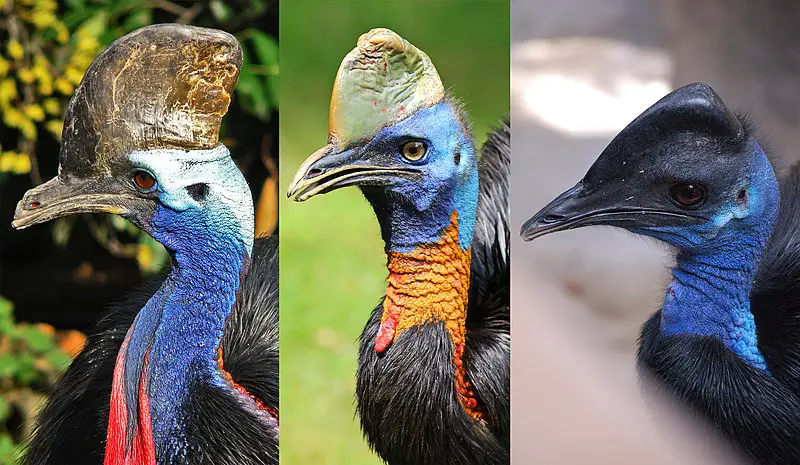
Cassowaries are unique, flightless birds belonging to the genus Casuarius. They are classified as ratites, and they do not have a keel on their sternum bones.
These fascinating birds are found in the tropical forests of New Guinea, Aru Islands, and northeastern Australia. Three species of cassowaries still exist, with the most prevalent being the Southern cassowary.
They are known for their crest, which protrudes from their heads, and their bright blue skin on their neck and head.
Cassowaries are also known for their sharp talons that can grow up to 12 centimeters long, and they can jump up to 1.5 meters high.
Cassowaries are often described as being dangerous as they have been known to attack humans when provoked, but they also play a vital role in their ecosystem as seed dispersers.
Scientific classification:
| Kingdom | Animalia |
| Phylum | Chordata |
| Class | Aves |
| Infraclass | Palaeognathae |
| Order | Casuariiformes |
| Family | Casuariidae Kaup, 1847[1] |
| Genus | Casuarius Brisson, 1760 |
Also Featured In: Birds That Live in the Jungle, Rainforest Birds You Should Know
46. Owls
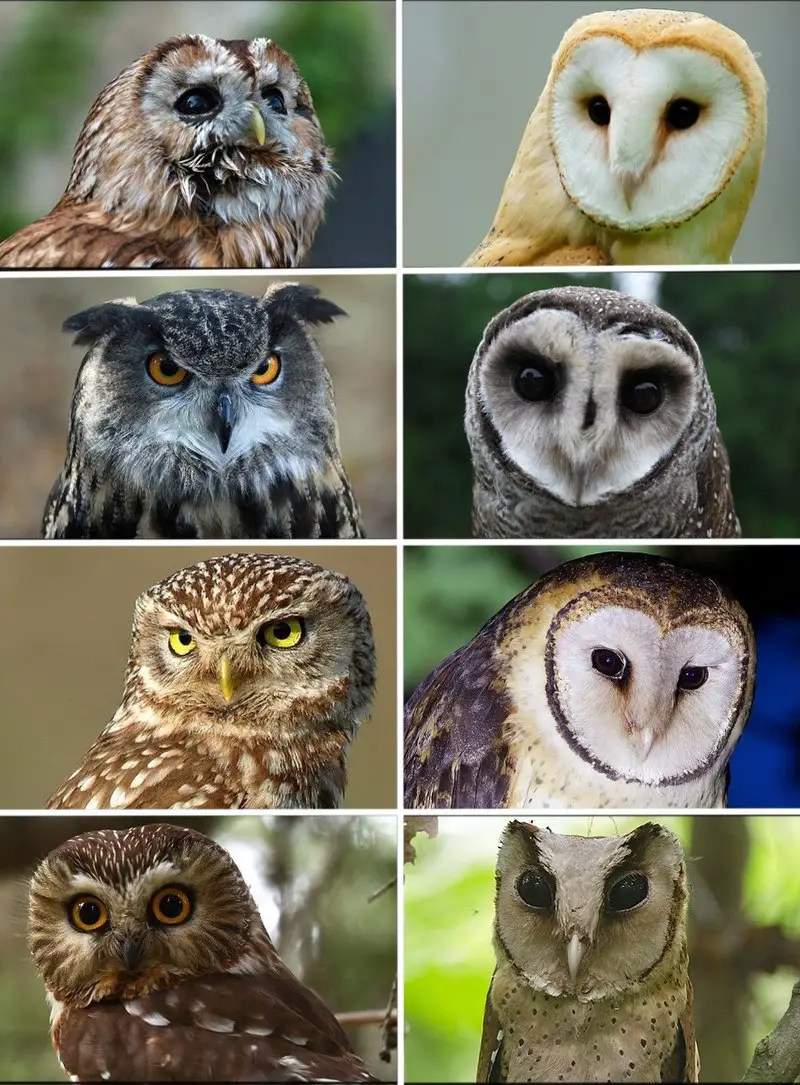
Owls are remarkable birds of prey that belong to the order Strigiformes. Known for their solitary and nocturnal behavior, these birds are commonly associated with an upright stance, broad head, binocular vision, binaural hearing, sharp talons, and specially adapted feathers for silent flight.
With over 200 species, owls are mostly carnivorous and hunt small mammals, making them excellent at controlling rodent populations.
Although most owls are solitary animals, some species, such as the gregarious burrowing owl, are social and interact regularly with their own kind.
Despite their nocturnal habits, some owls, like the northern hawk-owl, are diurnal and hunt during daylight hours.
All in all, owls are fascinating creatures that have intrigued bird watchers and scientists alike for many years.
Scientific classification:
| Kingdom | Animalia |
| Phylum | Chordata |
| Class | Aves |
| Clade | Telluraves |
| Order | Strigiformes Wagler, 1830 |
Also Featured In: Famous Paintings Birds, Flight Birds You Should Know
47. Common Ostrich
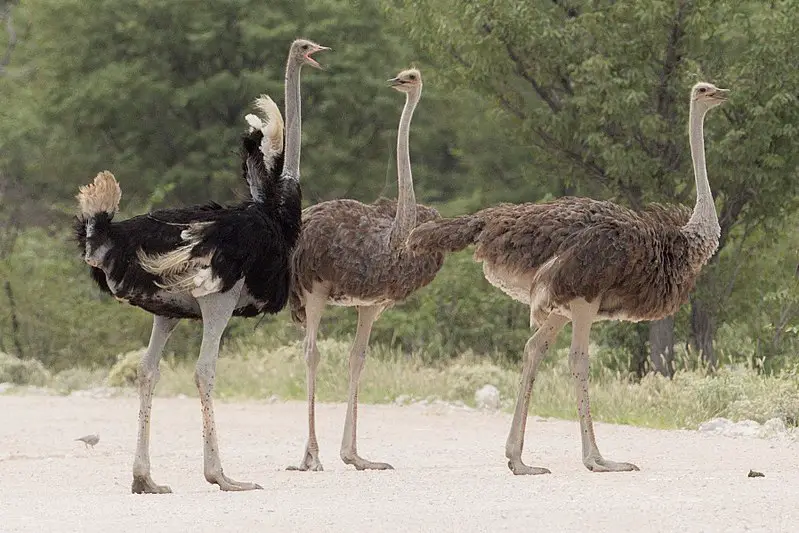
The common ostrich, also known as Struthio camelus, is a flightless bird and the largest living species of bird in the world.
They are native to specific regions of Africa and are the only living members of their genus, Struthio, in the ratite order of birds.
Another ostrich species, the Somali ostrich, is the only other member of the genus Struthio. Common ostriches are known for their long necks and legs, with their wings being too small for flight.
They have an omnivorous diet, feeding on plants, insects, and small animals.
During mating season, males engage in courtship displays and compete for mates, with the females laying their eggs in a communal nest.
These birds are important ecologically and culturally, but they are also threatened by habitat loss and hunting for their meat, feathers, and skin.
Scientific classification:
| Kingdom | Animalia |
| Phylum | Chordata |
| Class | Aves |
| Infraclass | Palaeognathae |
| Order | Struthioniformes |
| Family | Struthionidae |
| Genus | Struthio |
| Species | S. camelus |
Also Featured In: African Birds, Birds that Live in the Deserts
48. African Penguin
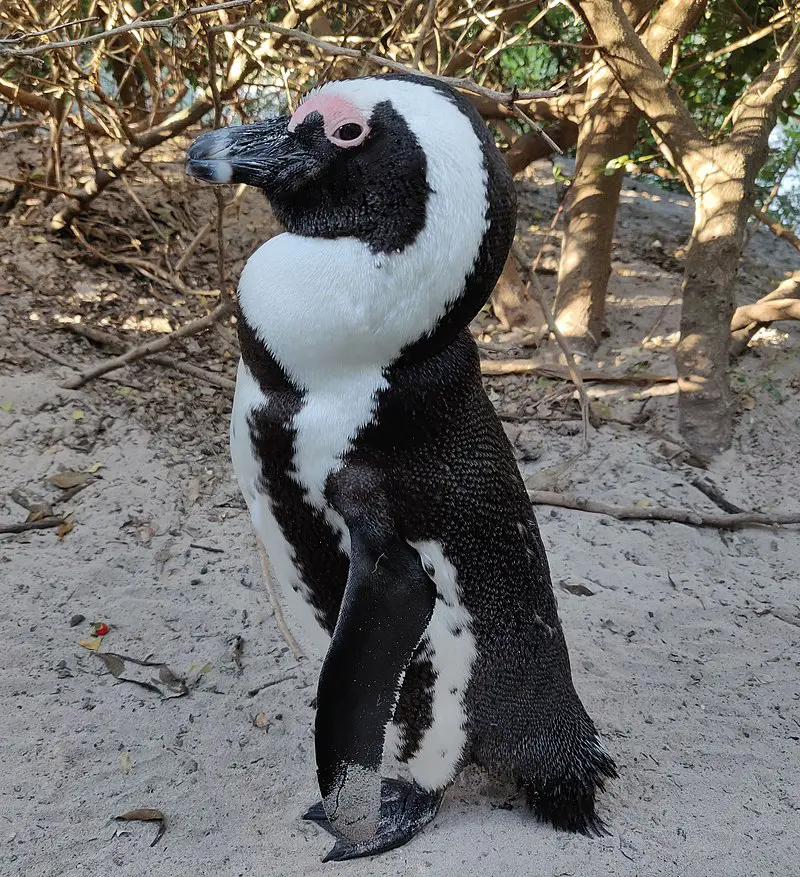
The African penguin, also known as the Cape penguin or South African penguin, is a flightless bird found only in southern African waters.
With a streamlined body and flippers adapted for a marine habitat, it is similar to all other extant penguins.
Adult African penguins can weigh between 2.2–3.5kg (4.9–7.7lb) and reach heights of 60–70cm (24–28in).
Unfortunately, the species is under threat due to habitat loss, food scarcity, and human impact such as oil spills and overfishing.
Conservation efforts are underway to protect this vulnerable species.
Scientific classification:
| Kingdom | Animalia |
| Phylum | Chordata |
| Class | Aves |
| Order | Sphenisciformes |
| Family | Spheniscidae |
| Genus | Spheniscus |
| Species | S. demersus |
Also Featured In: Birds that Live in the Ocean ,
49. Sea Eagle
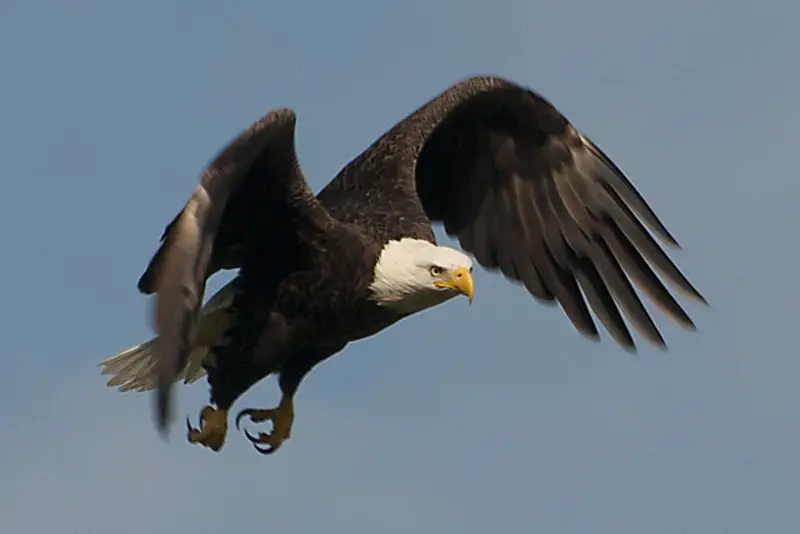
Sea eagles are a type of bird of prey found in the genus Haliaeetus within the Accipitridae family. These majestic birds are also known as fish eagles or ernes, particularly in reference to their distinctive white-tailed appearance.
The genus Haliaeetus was first described in 1809 by French naturalist Marie Jules César Savigny.
Sea eagles are adept hunters and are particularly skilled at catching fish, using their impressive talons to snatch their prey from the water’s surface.
While the majority of sea eagles live in coastal areas, some also inhabit inland rivers and lakes.
These birds are admired for their beauty, strength, and keen hunting instincts, and are a popular subject for wildlife photography and conservation efforts.
Scientific classification:
| Kingdom | Animalia |
| Phylum | Chordata |
| Class | Aves |
| Order | Accipitriformes |
| Family | Accipitridae |
| Subfamily | Haliaeetinae |
| Genus | Haliaeetus Savigny, 1809 |
Also Featured In: Birds that Live in Greenland, Large African Birds You Need to Know
50. Ostriches

Ostriches are massive birds that cannot fly. They lay the biggest eggs amongst land animals. These birds are remarkable sprinters, with a top speed of 70 km/h.
They are farmed in several countries, with the Philippines and Namibia being the most significant producers.
Famed for their leather, ostriches are bred for their hides, which are in high demand for their durability and aesthetics.
Their long and thick plumes are often used as decorations or in fashion accessories.
Despite their size, ostriches are primarily herbivores, feeding on shoots, leaves, flowers, and grass. They are social animals and live in groups of up to 50 in the wild.
Scientific classification:
| Kingdom | Animalia |
| Phylum | Chordata |
| Class | Aves |
| Infraclass | Palaeognathae |
| Order | Struthioniformes |
| Family | Struthionidae |
| Genus | Struthio Linnaeus, 1758[1] |
Also Featured In: Most Common Nature Birds, Savanna Birds You Need to See
51. Golden-Breasted Starling
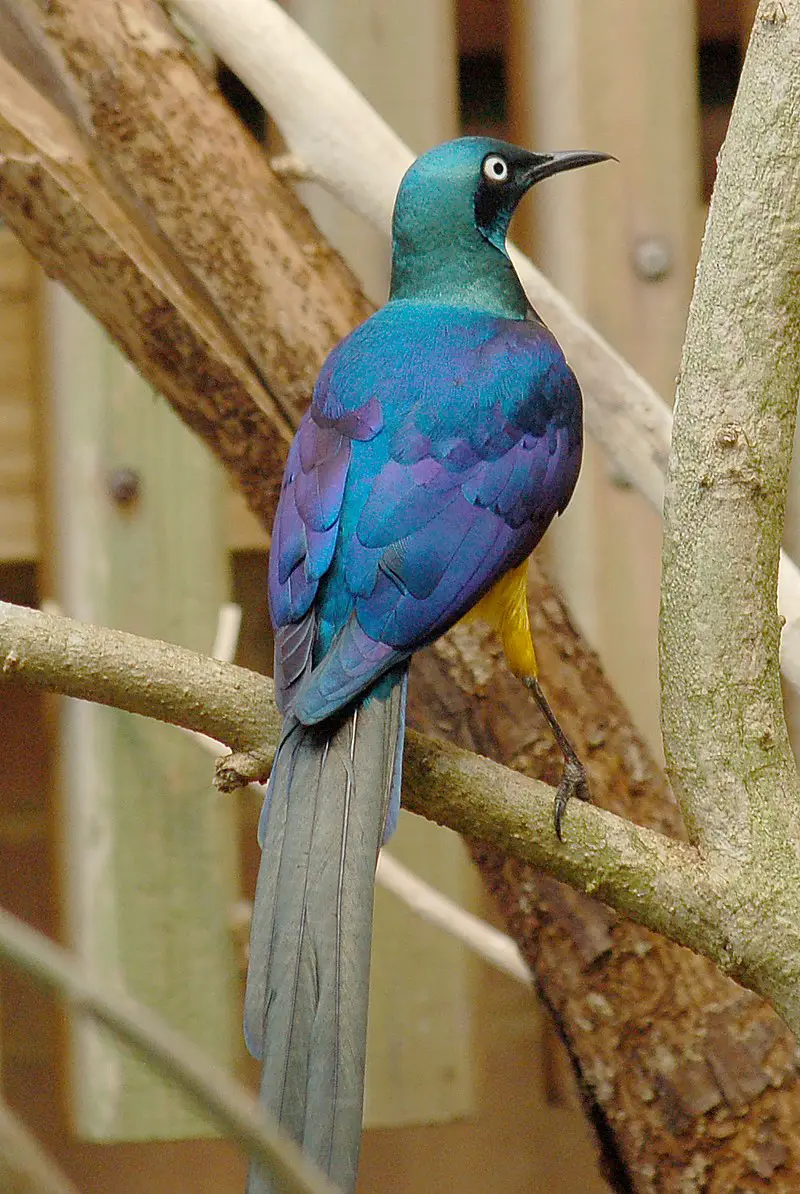
The golden-breasted starling, also known as the royal starling, is a medium-sized passerine that can be found in Northeastern Africa. They inhabit a variety of environments, including grasslands, savannahs, and dry-thorn forests.
With a very large range, they are distributed in countries such as Somalia, Ethiopia, Kenya, and northern Tanzania. These birds have a striking appearance, with a golden breast and blue-black feathers on the rest of the body.
Known for their vocalization abilities, they are skilled mimics and can imitate a variety of sounds in their environment.
The golden-breasted starling plays an important role in the ecosystem as seed dispersers, helping to ensure the continuation of plant species.
Overall, this bird is a valuable and unique part of the avian world in Africa.
Scientific classification:
| Kingdom | Animalia |
| Phylum | Chordata |
| Class | Aves |
| Order | Passeriformes |
| Family | Sturnidae |
| Genus | Lamprotornis |
| Species | L. regius |